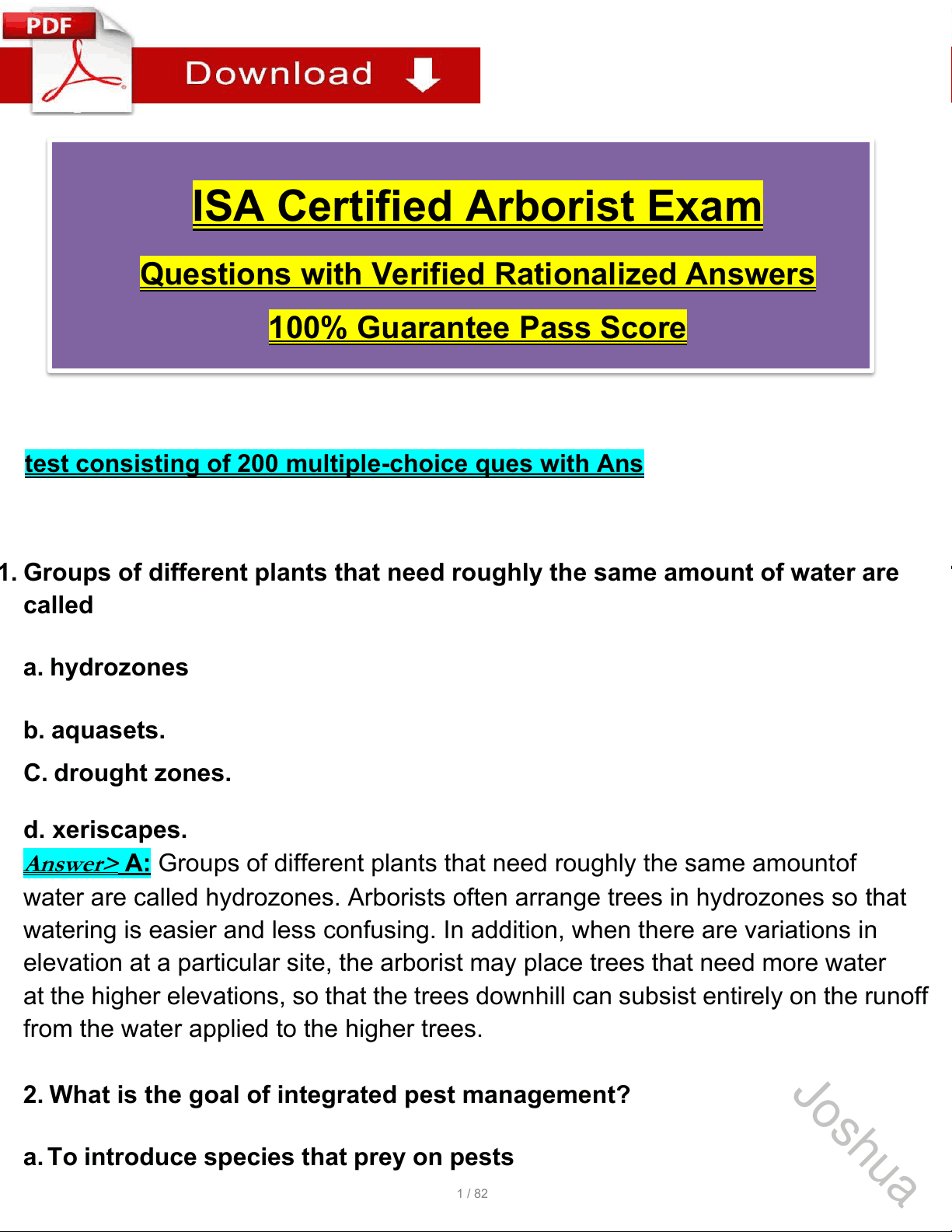
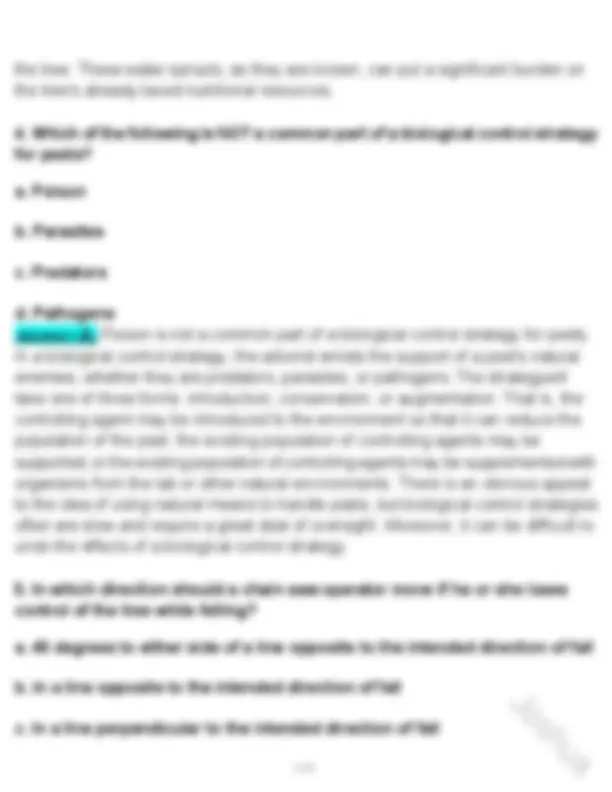
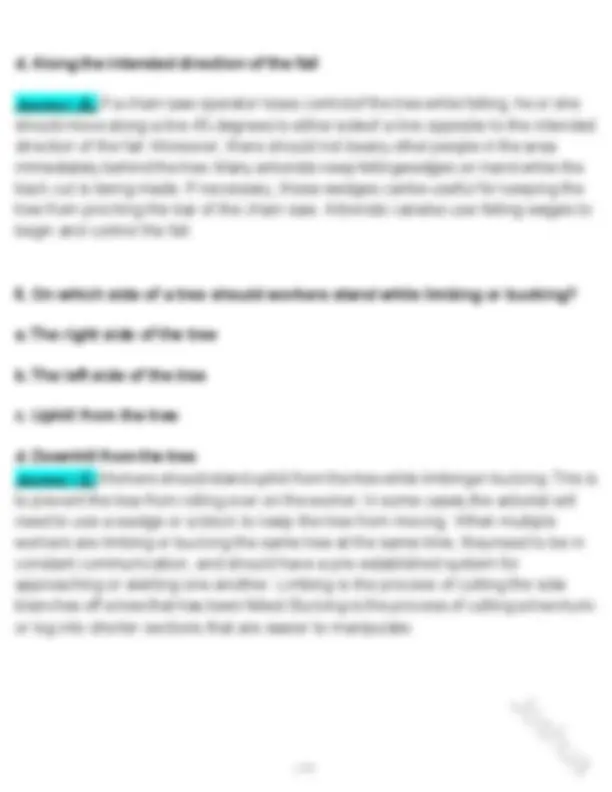
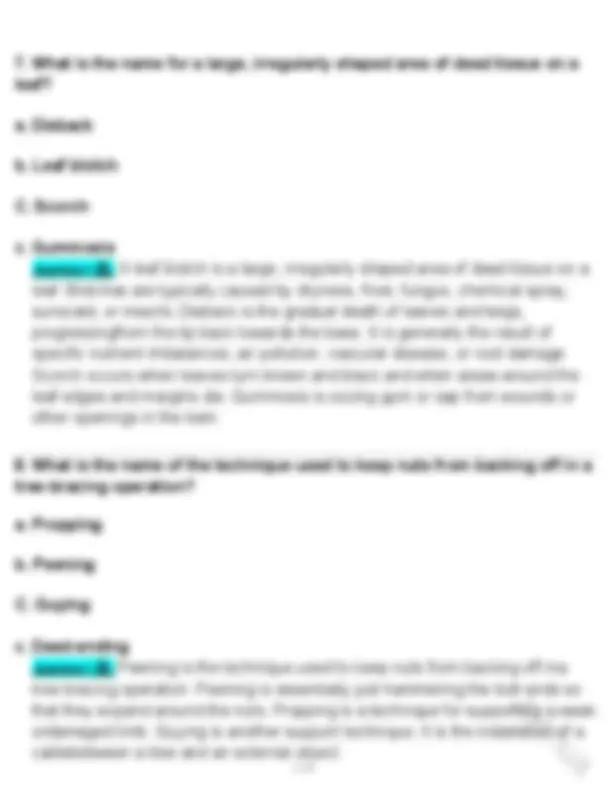
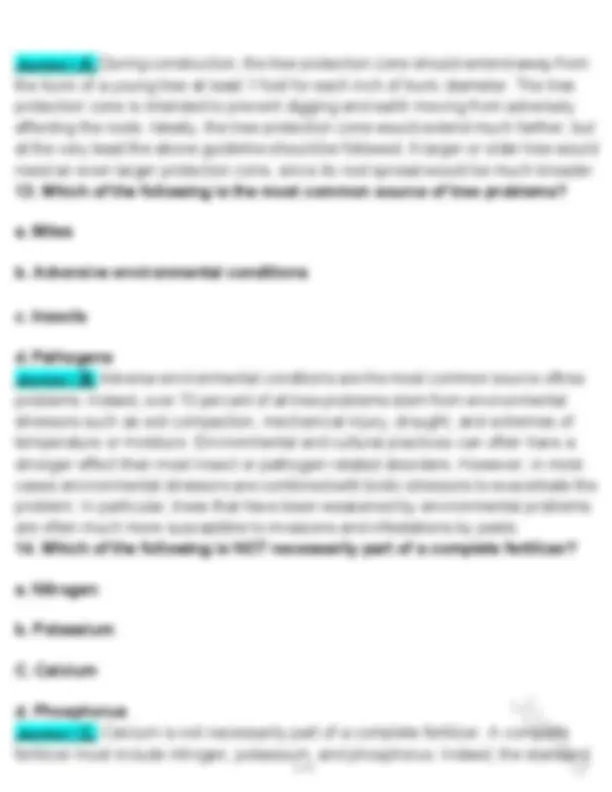
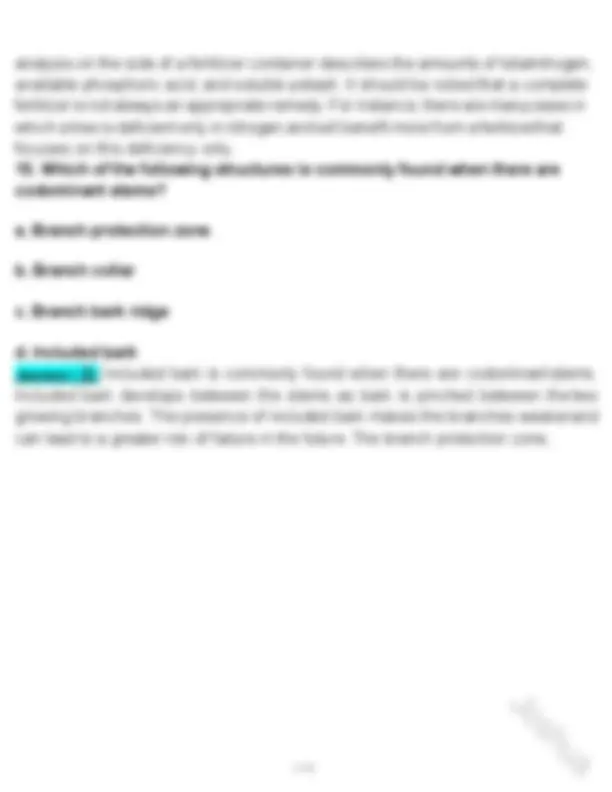
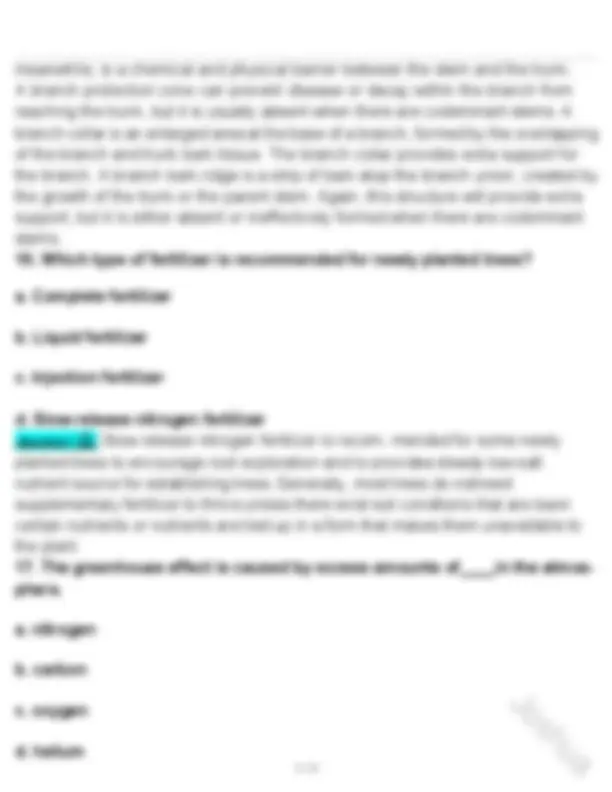
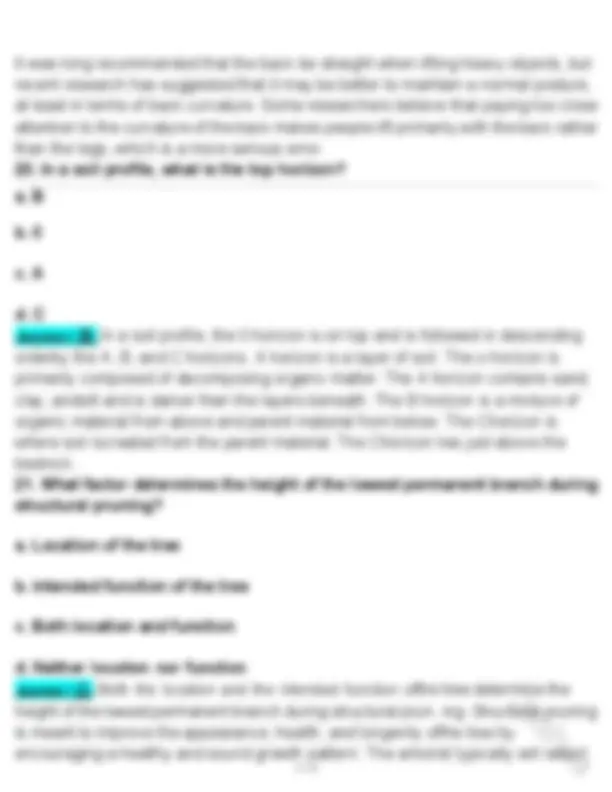
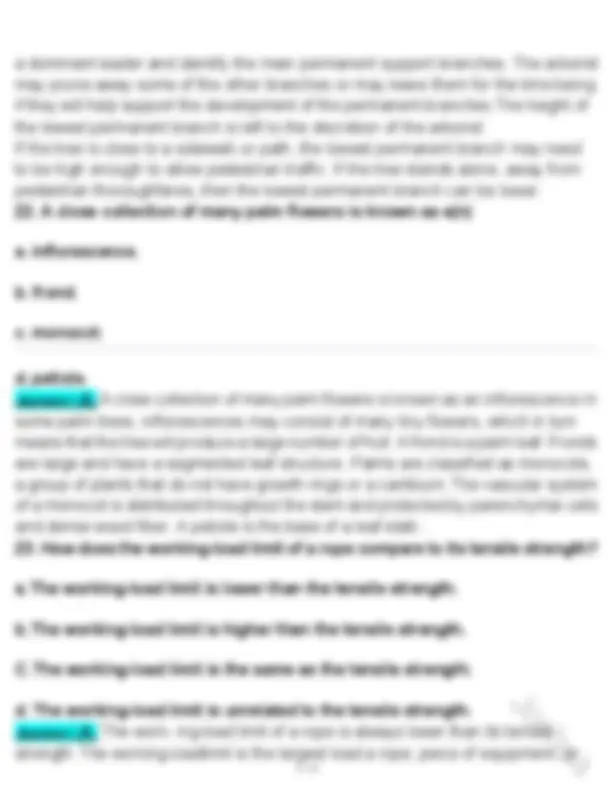
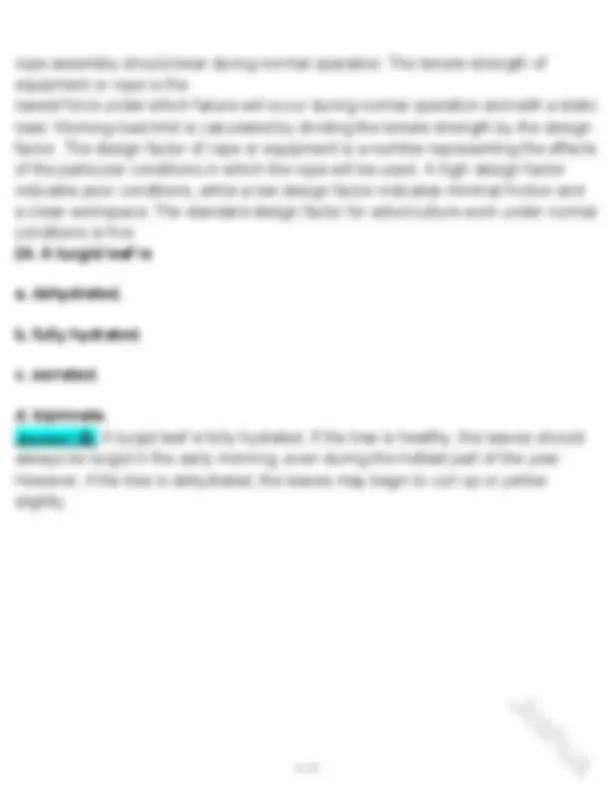
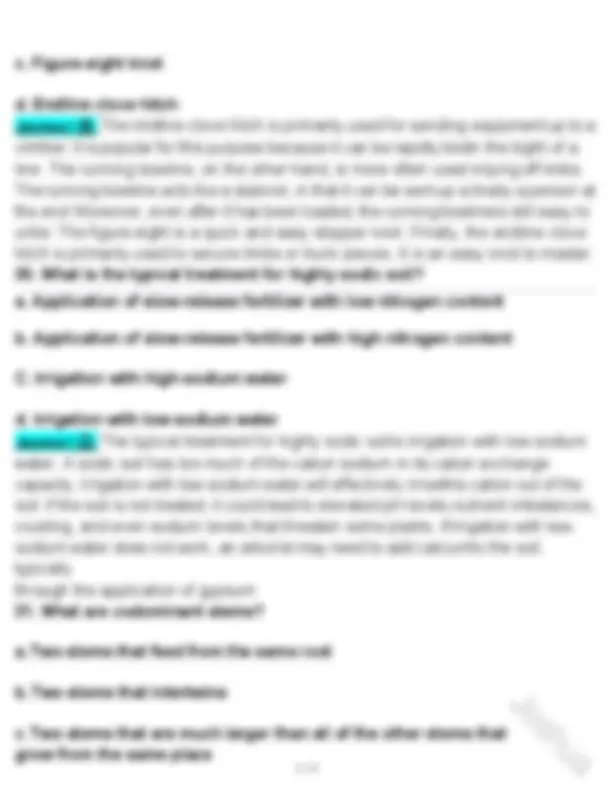

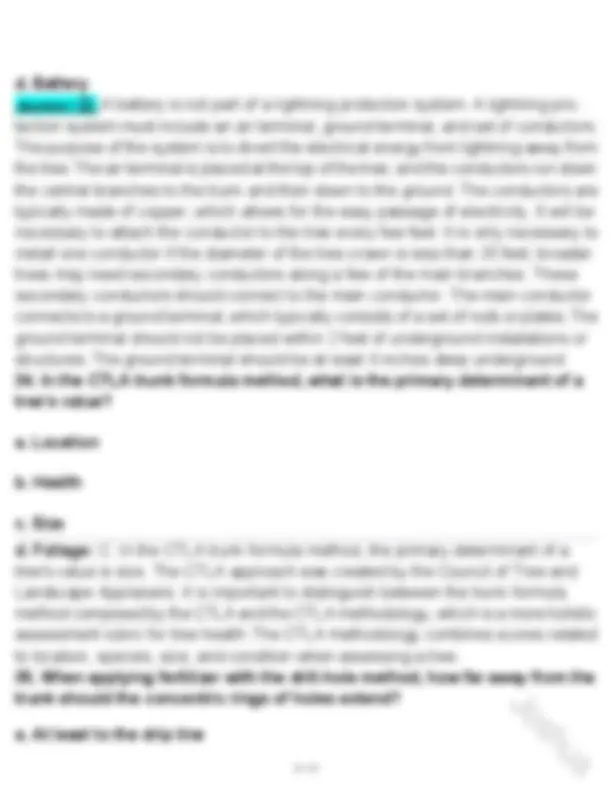
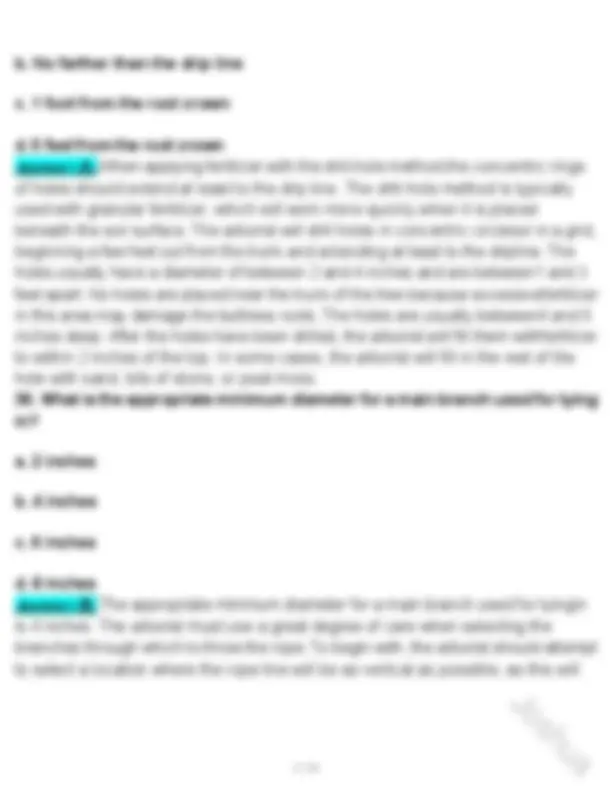
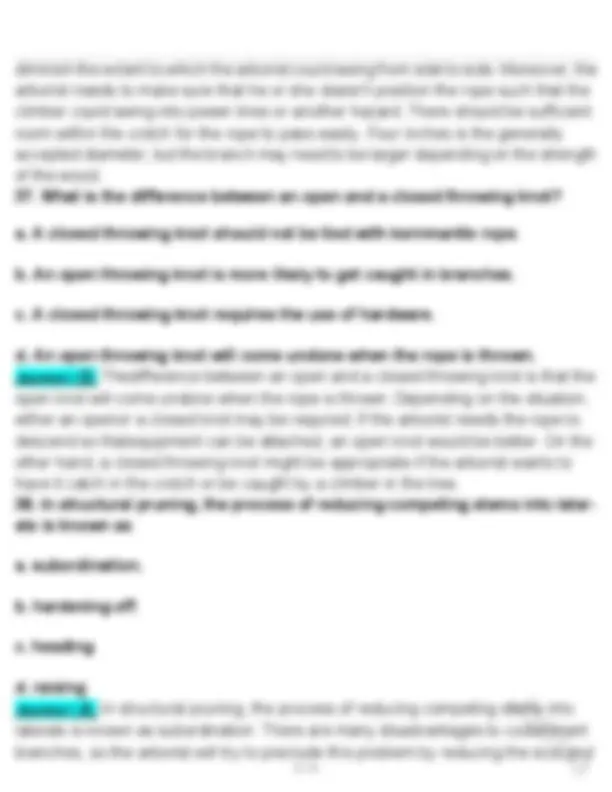
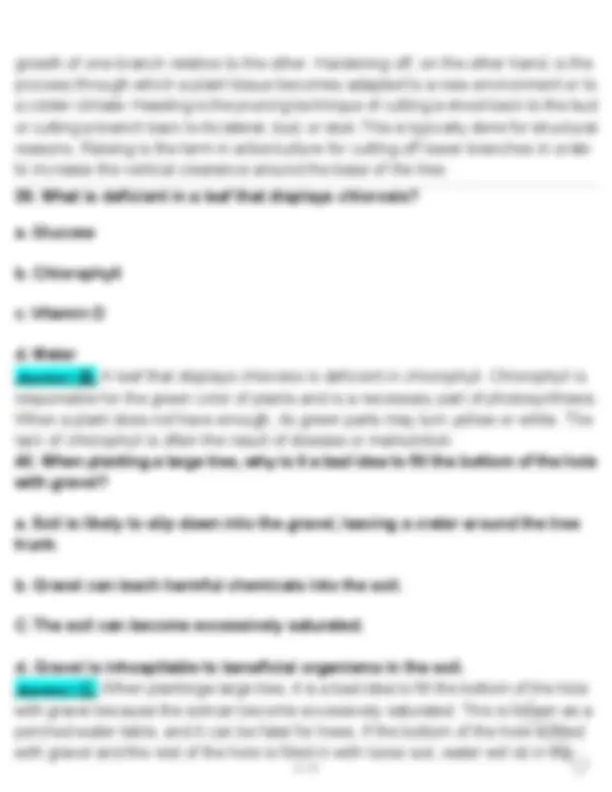
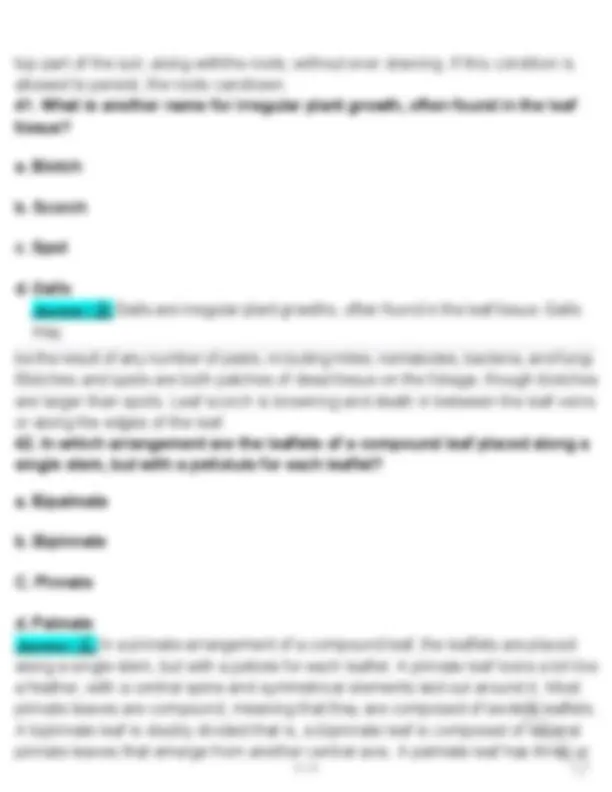
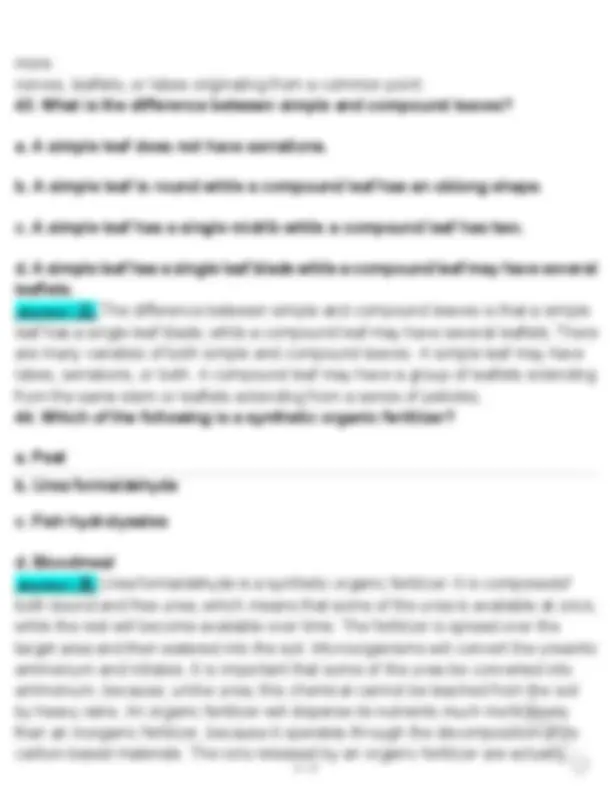
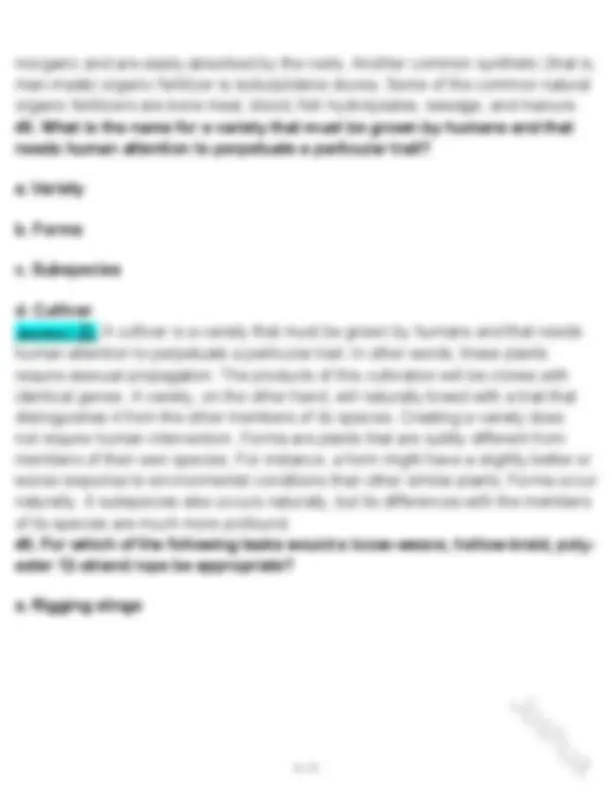
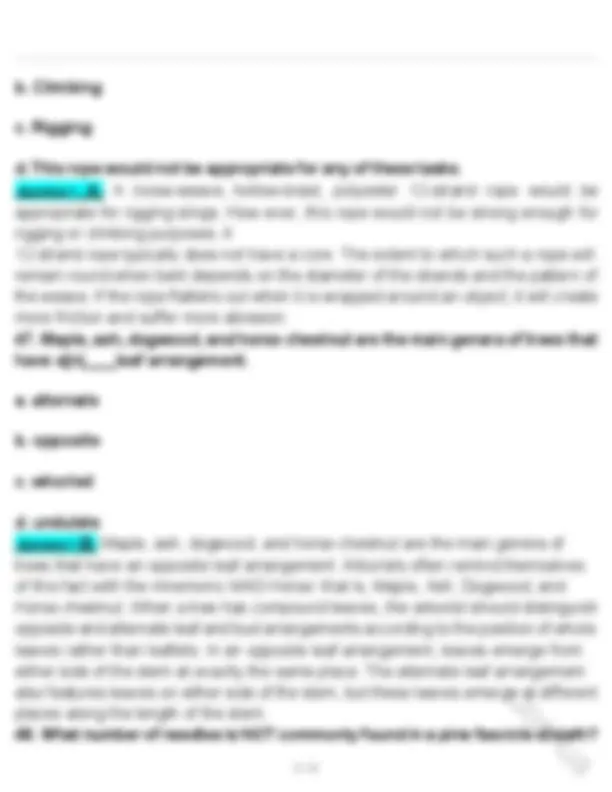
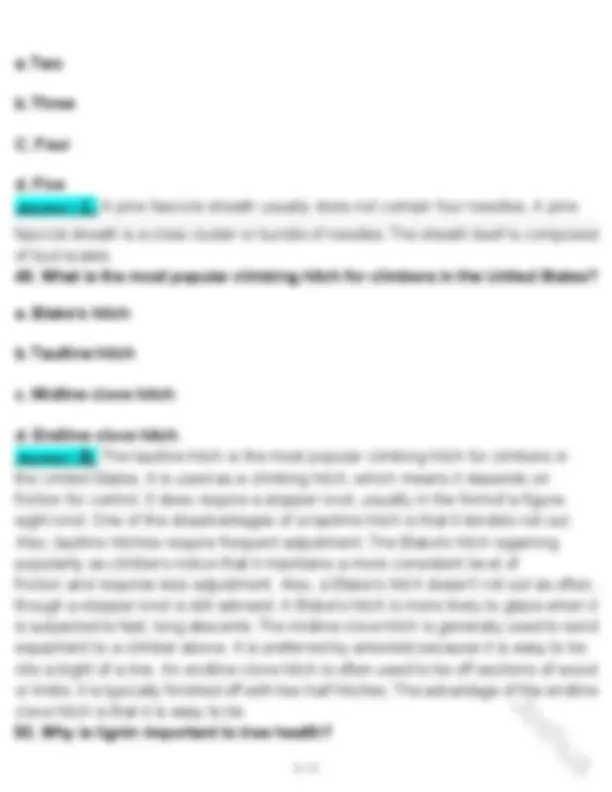
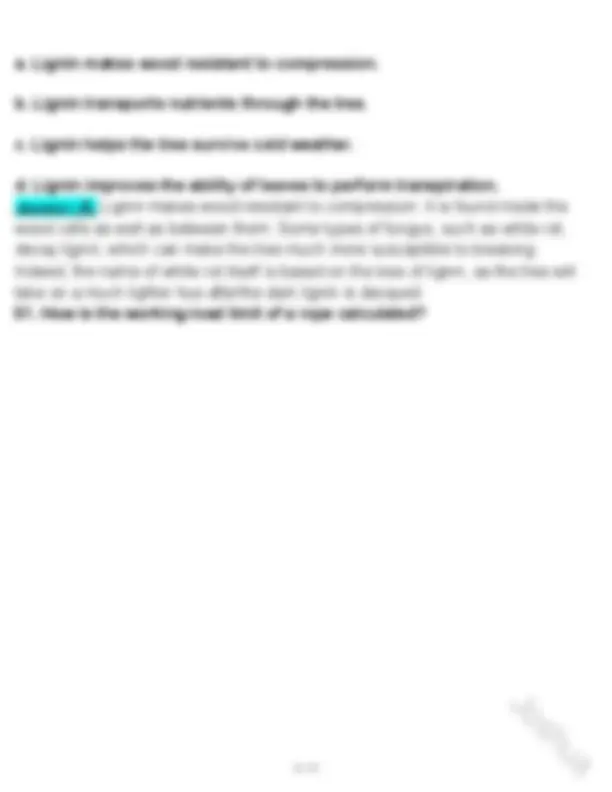
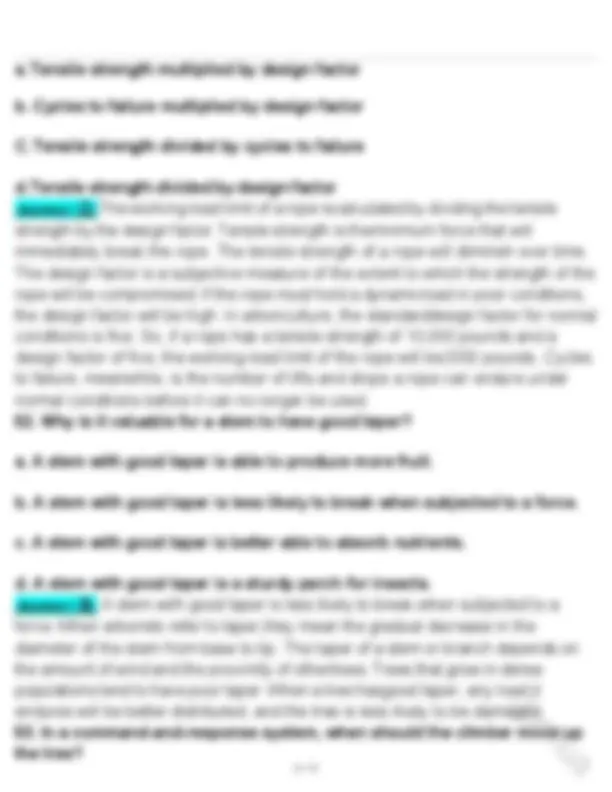

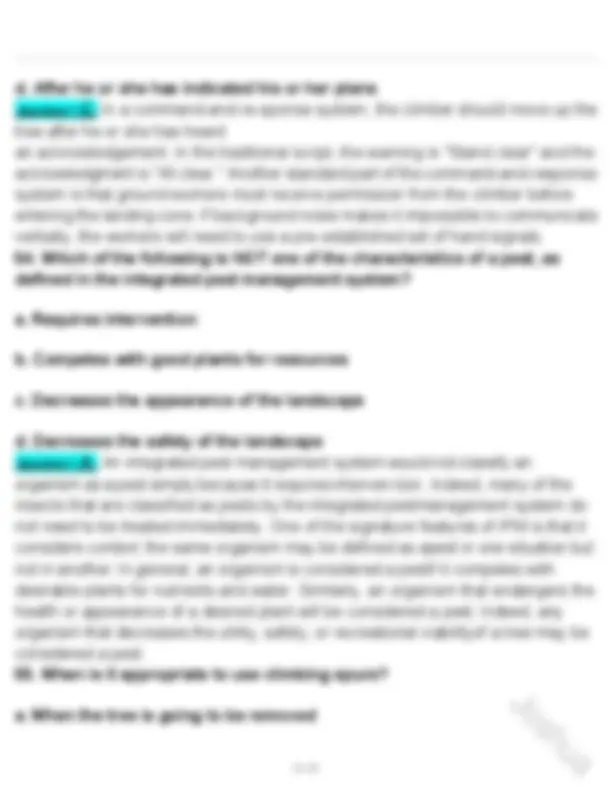
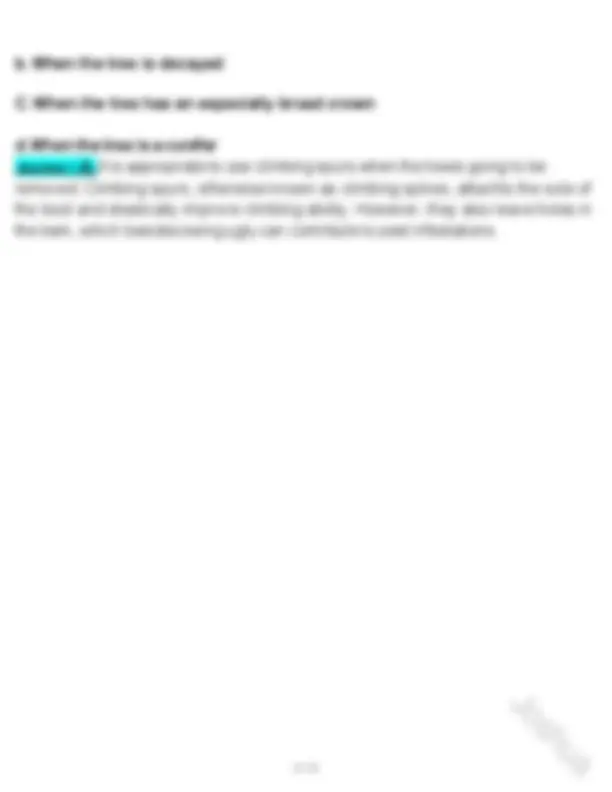
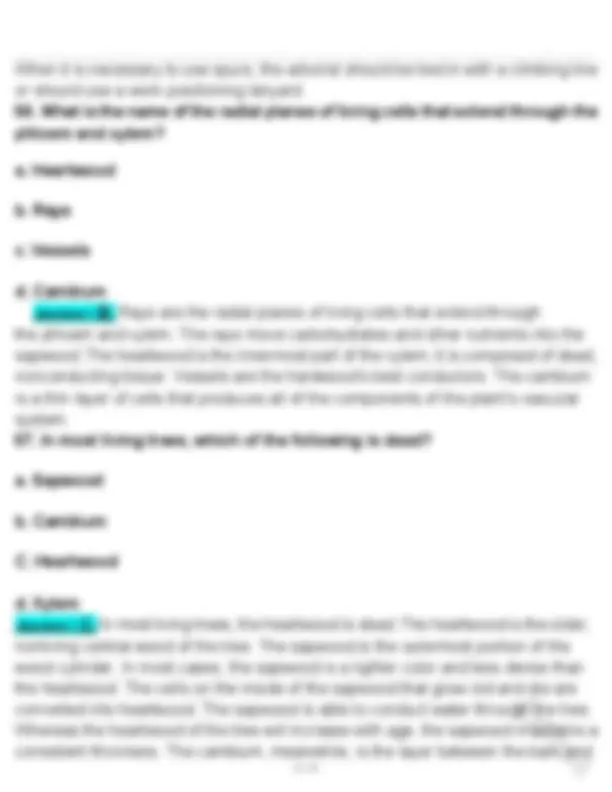

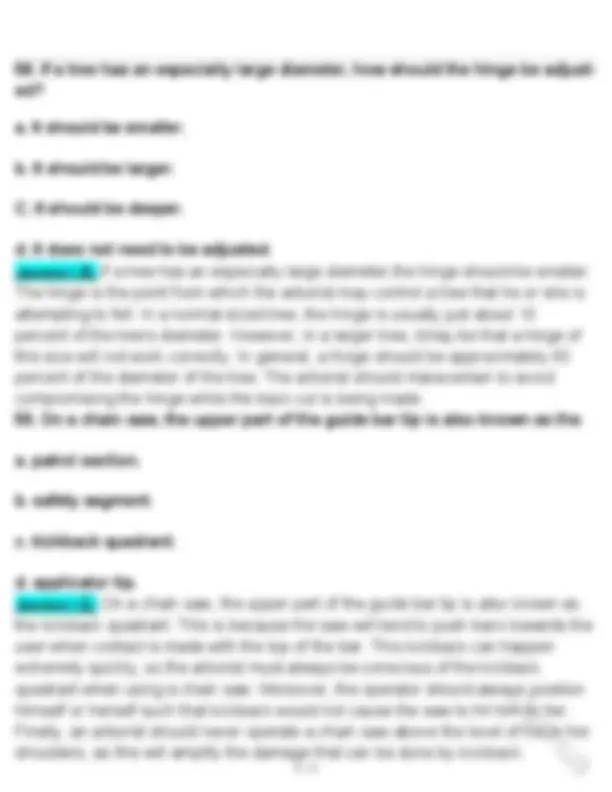
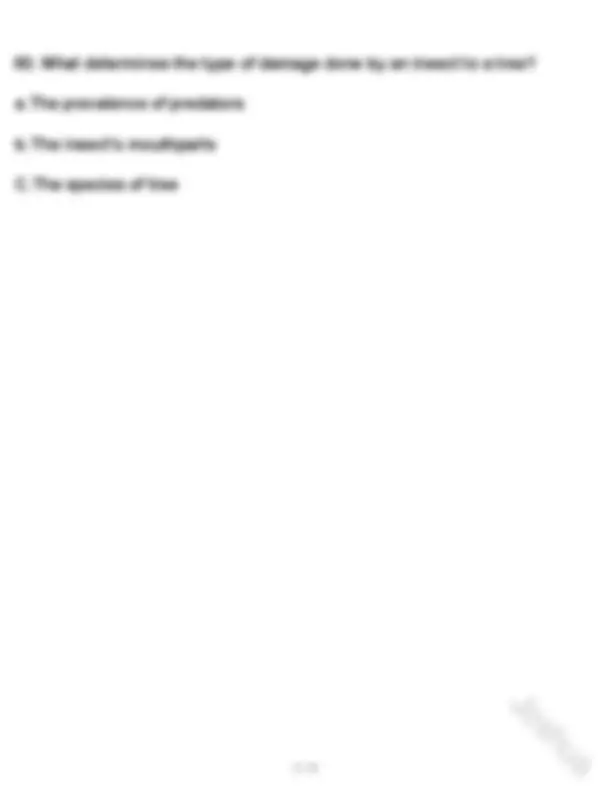
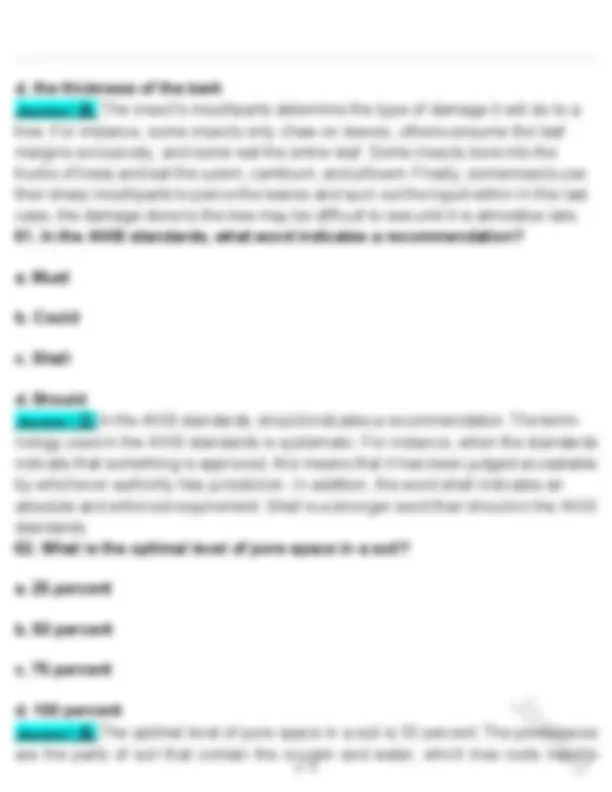

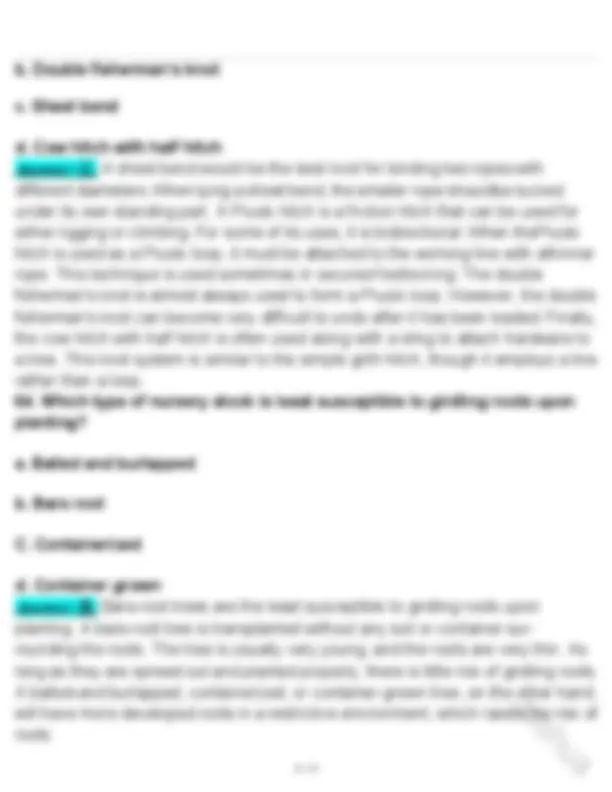
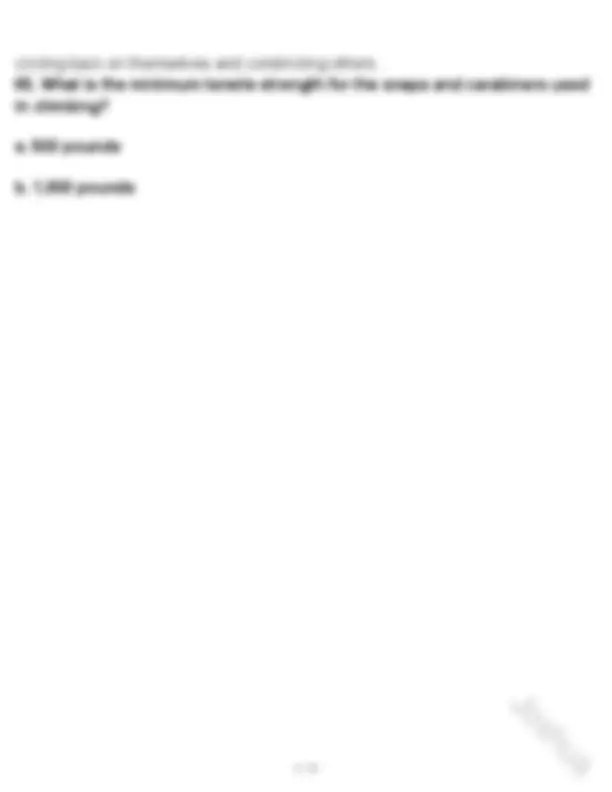
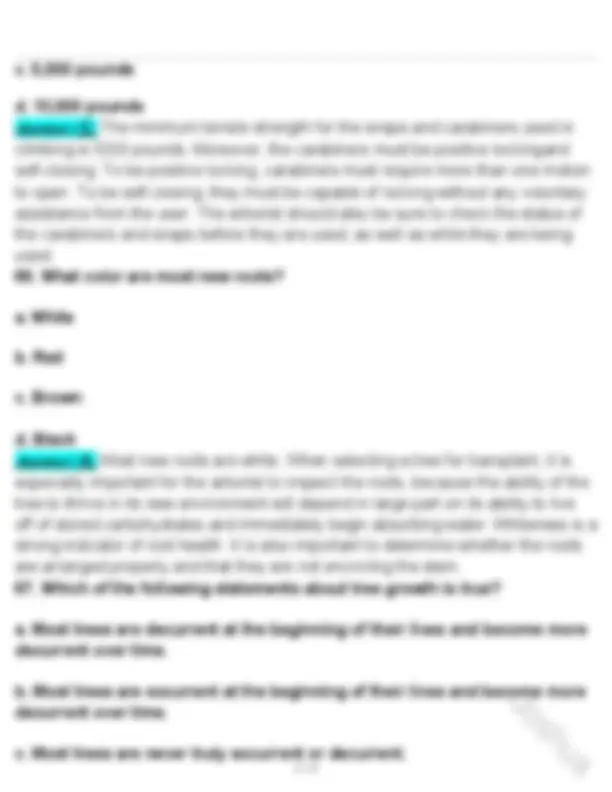
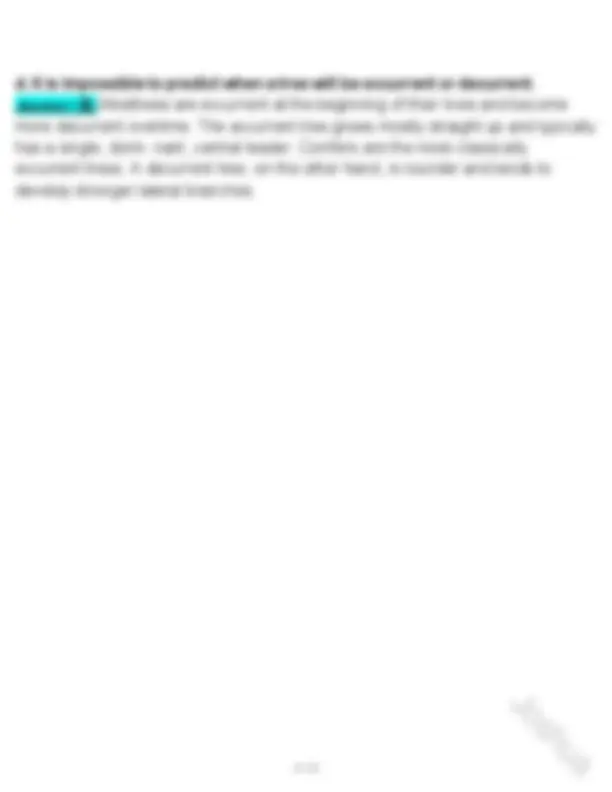
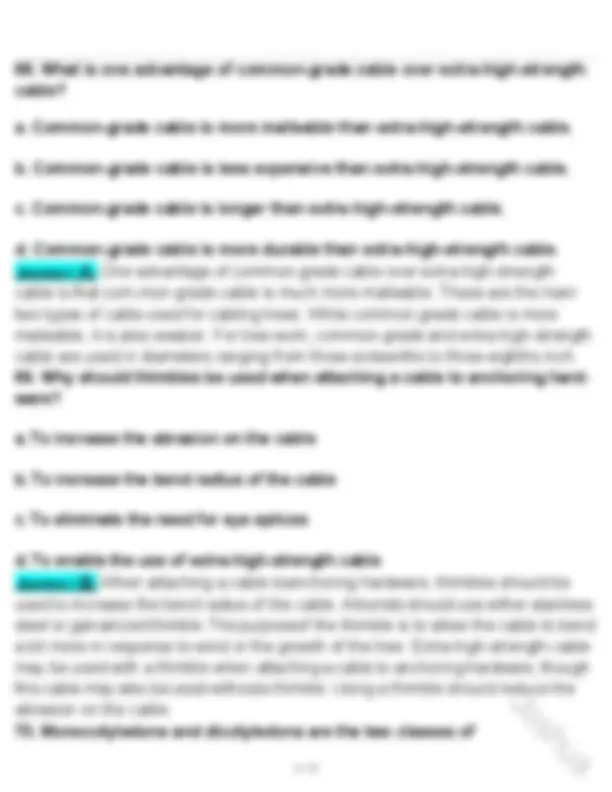

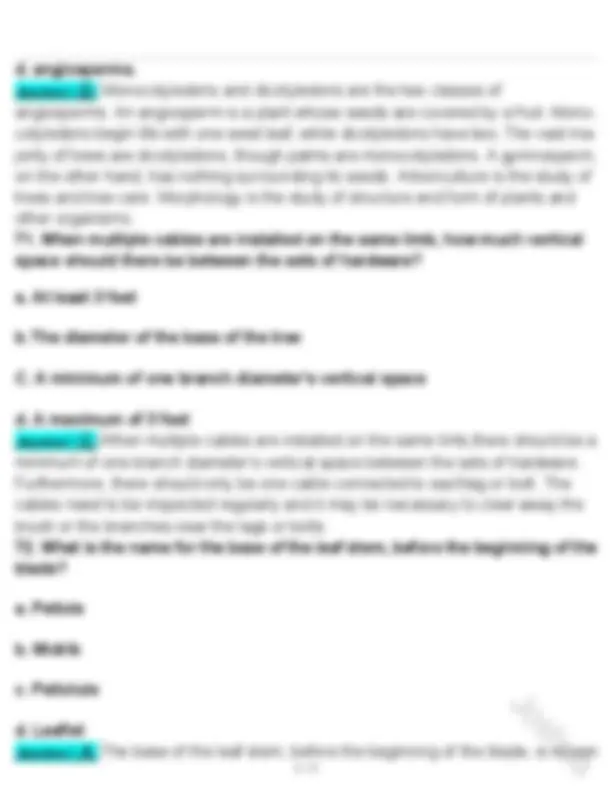
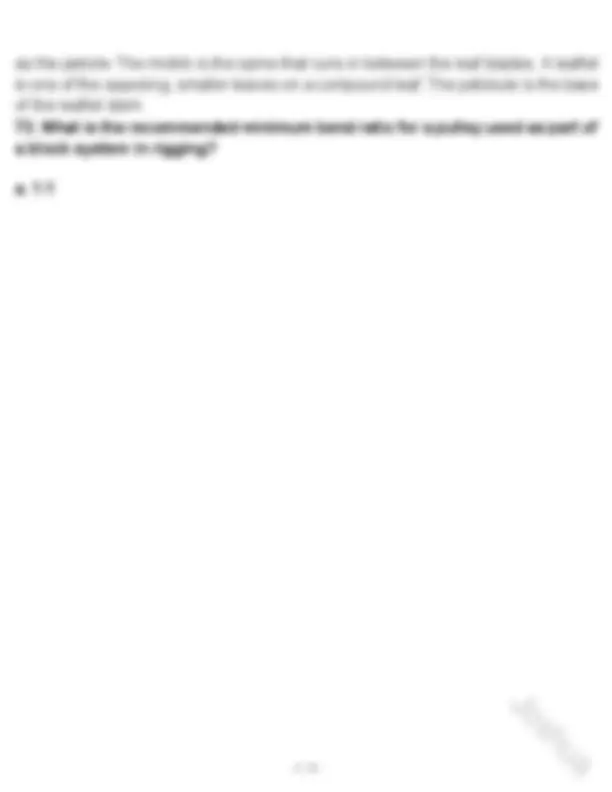
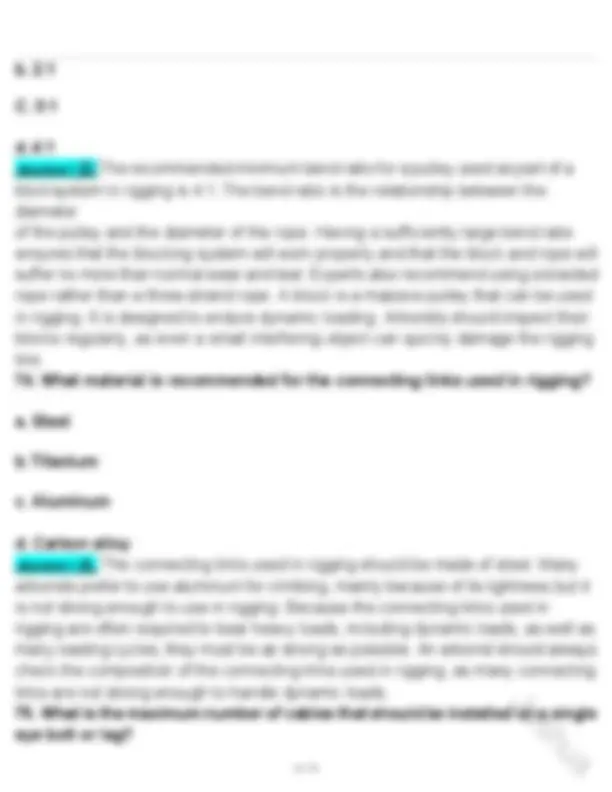
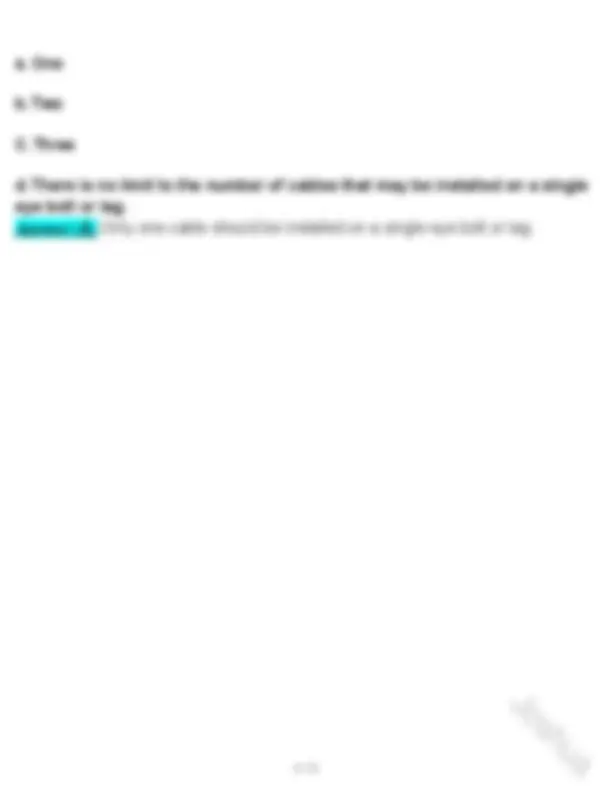
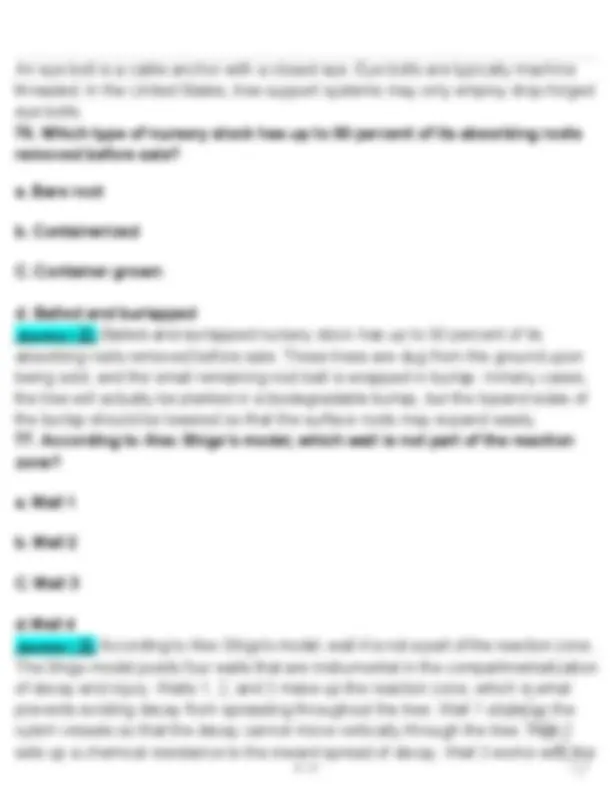

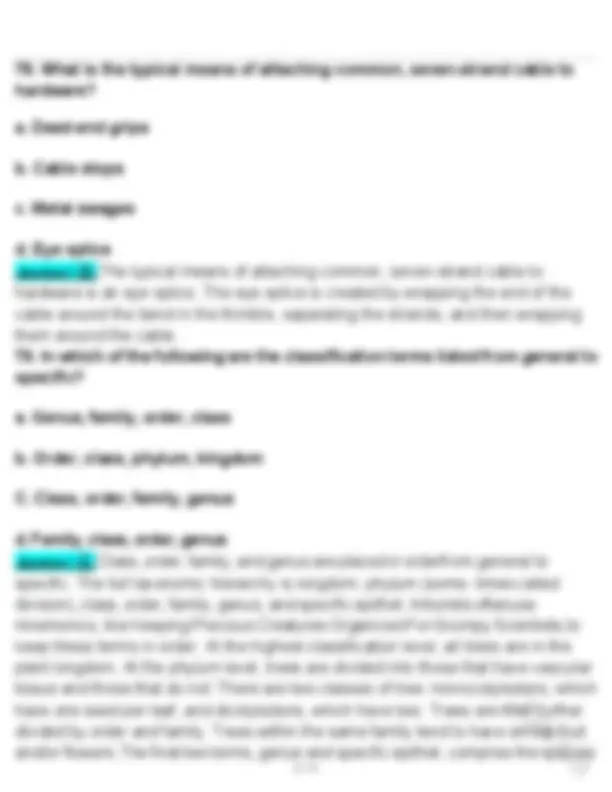

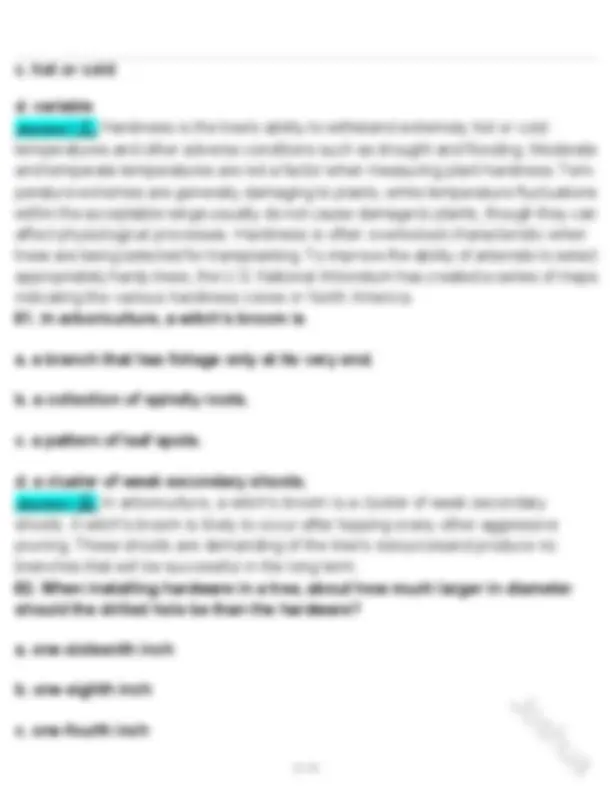
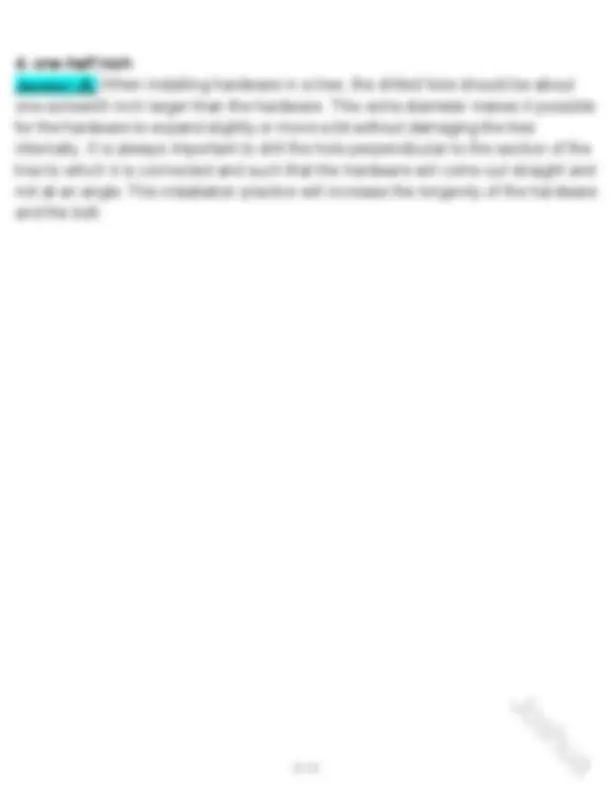
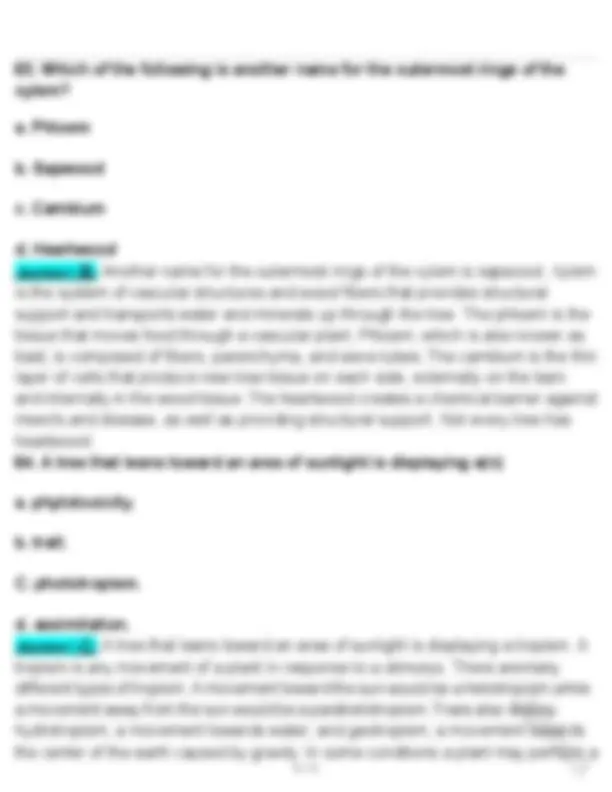
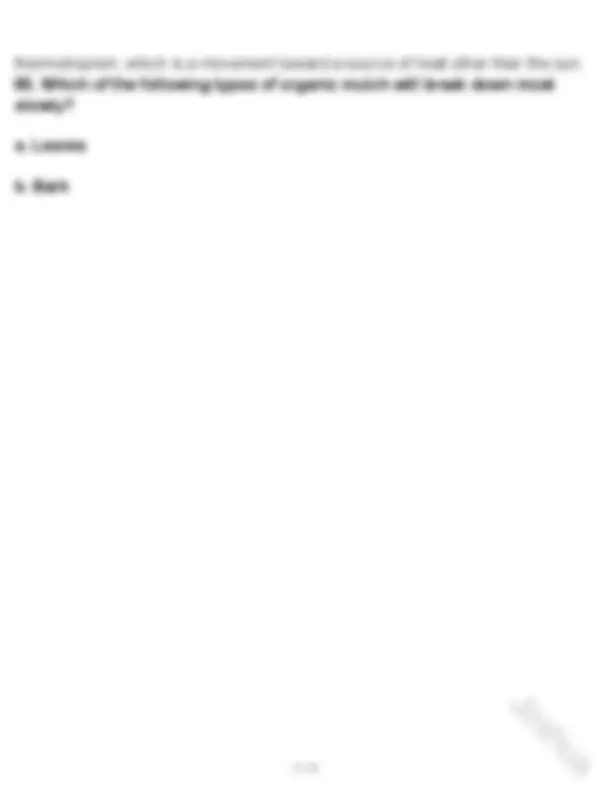
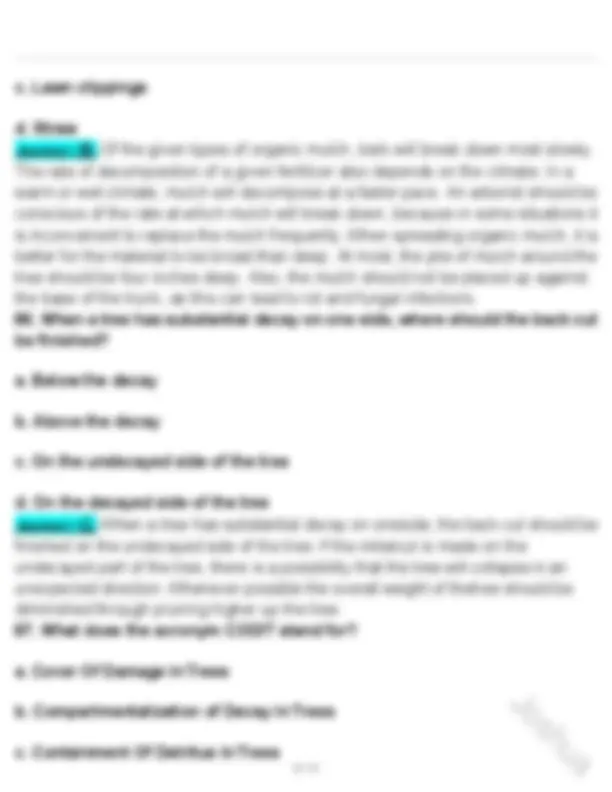
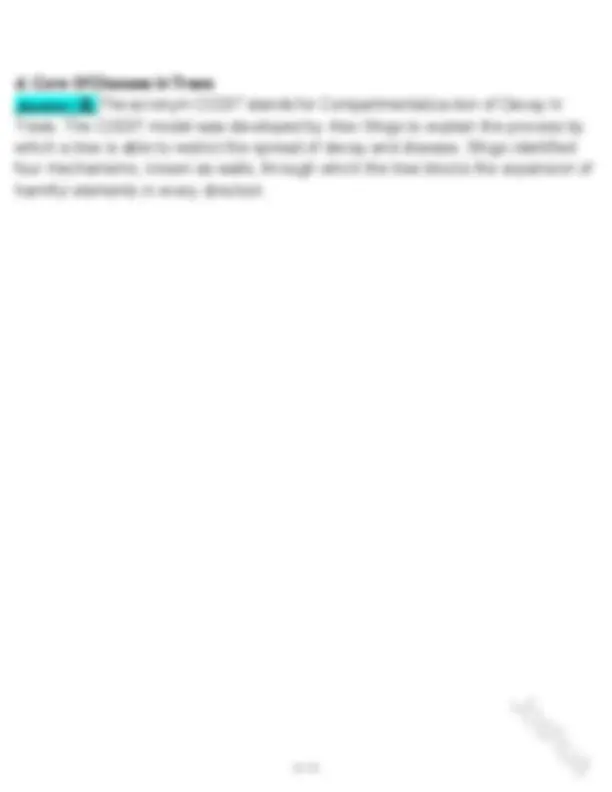
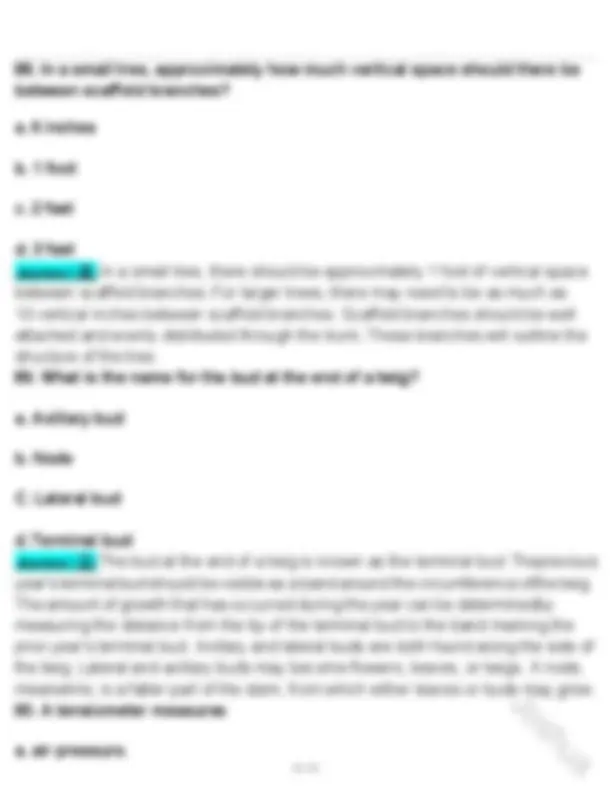
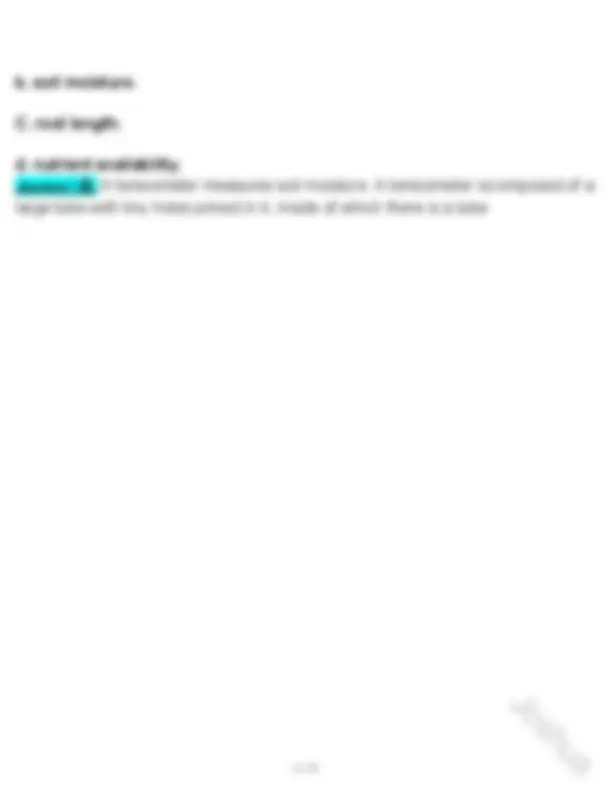
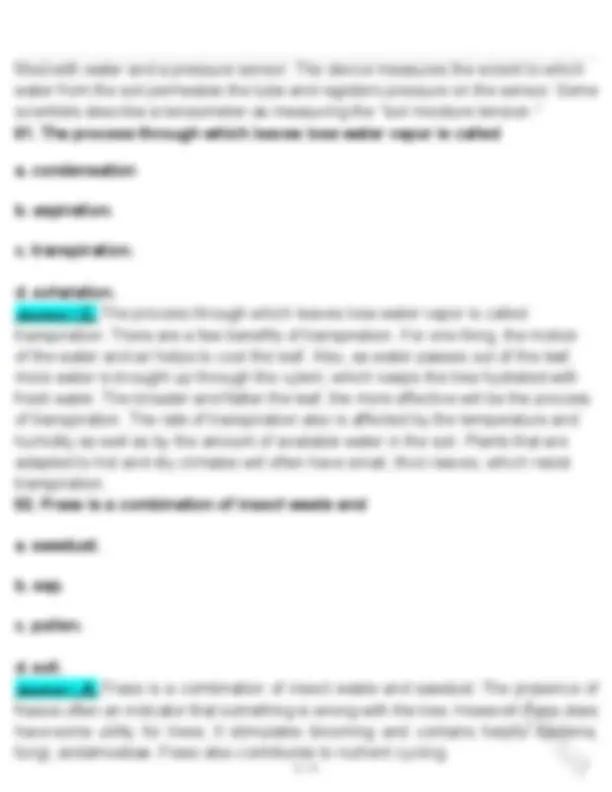
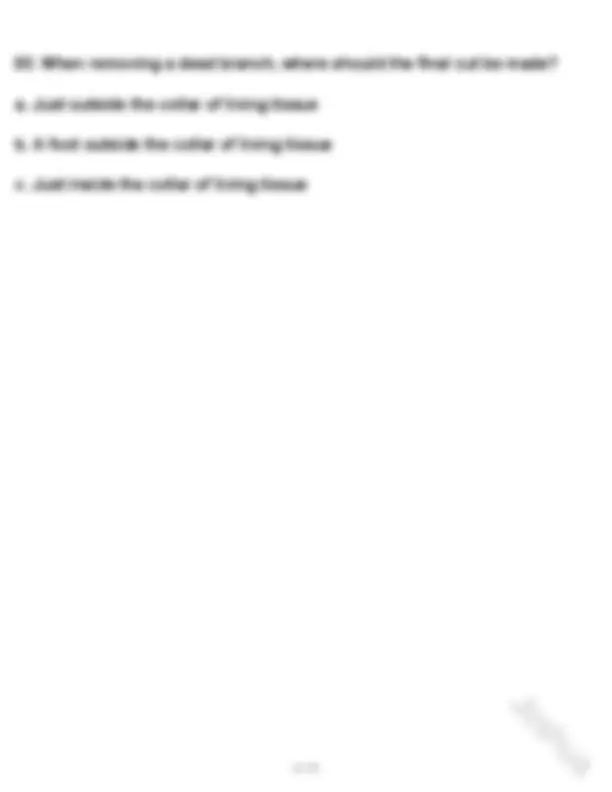
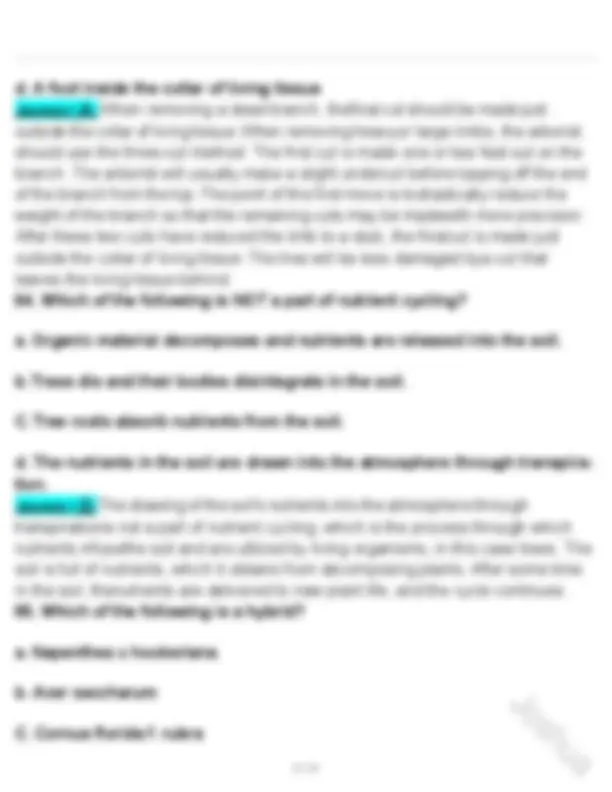
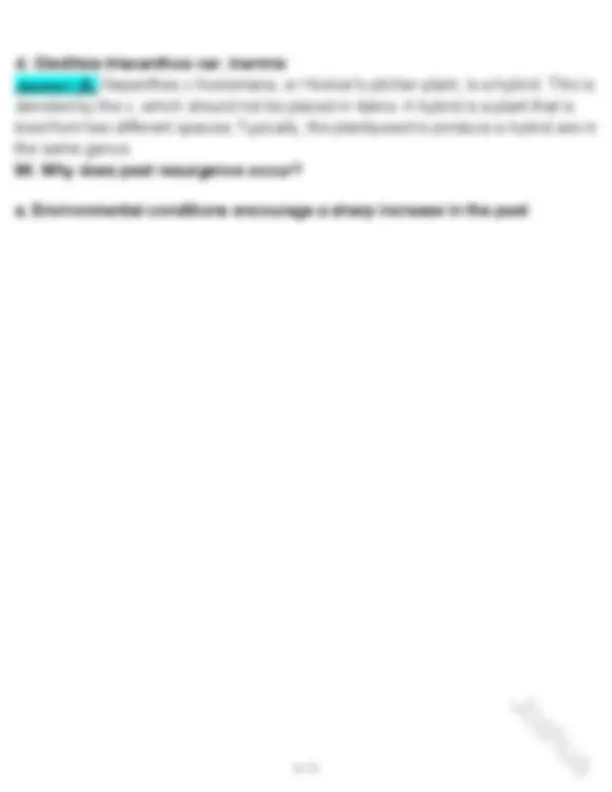
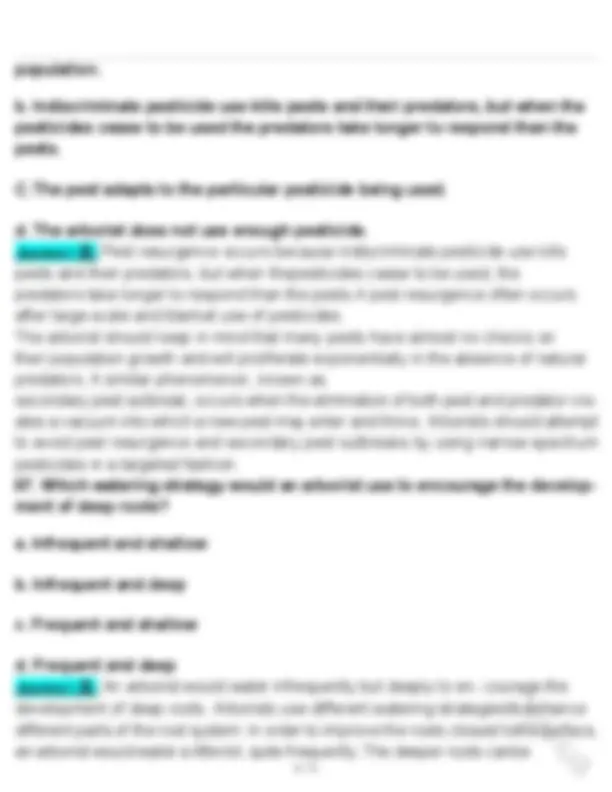
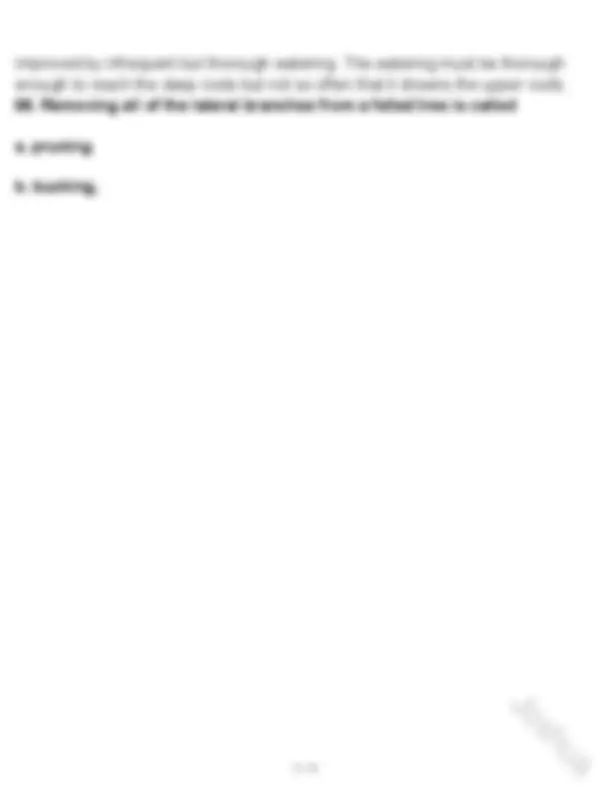
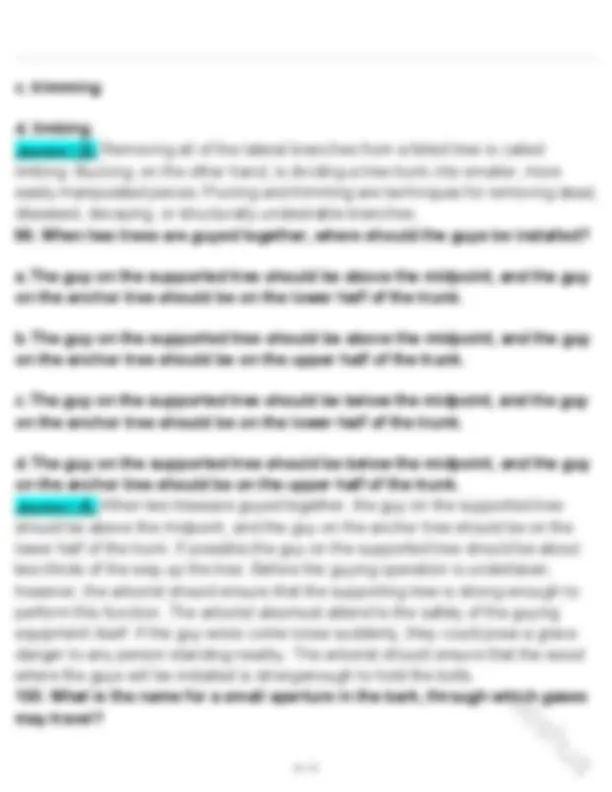
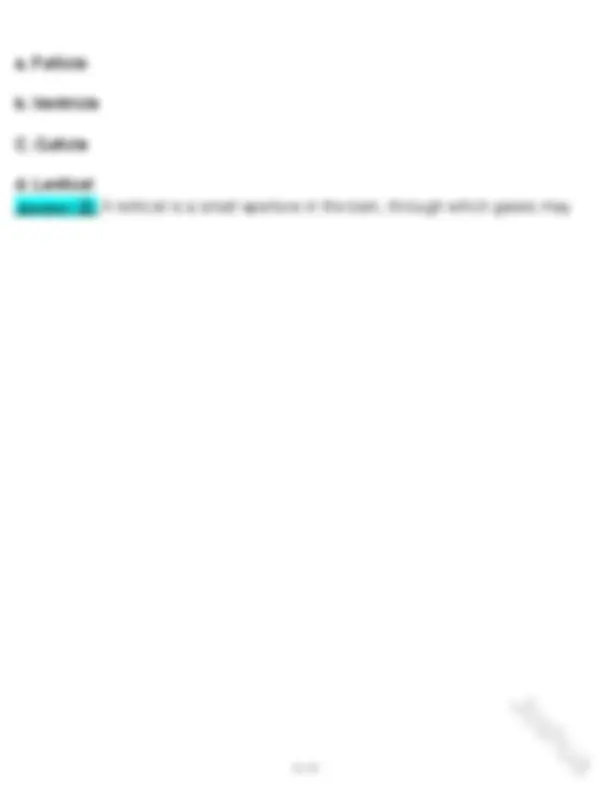
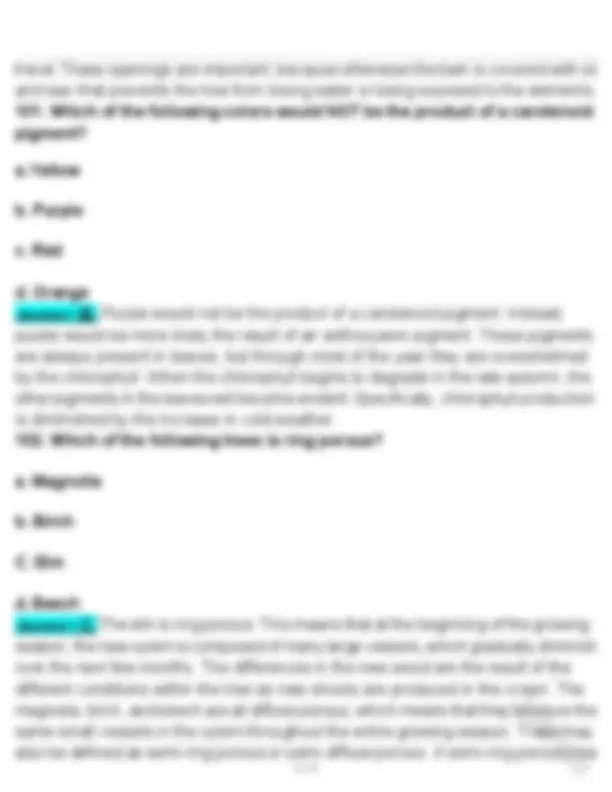

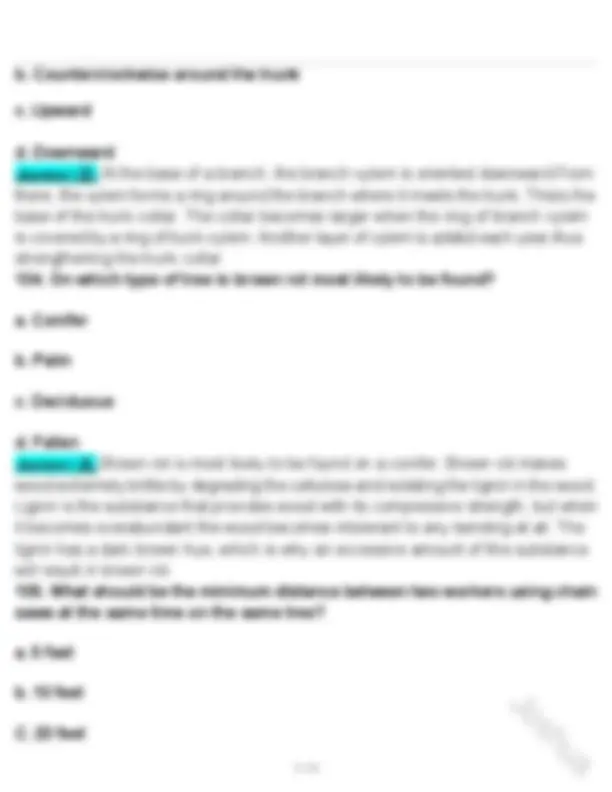
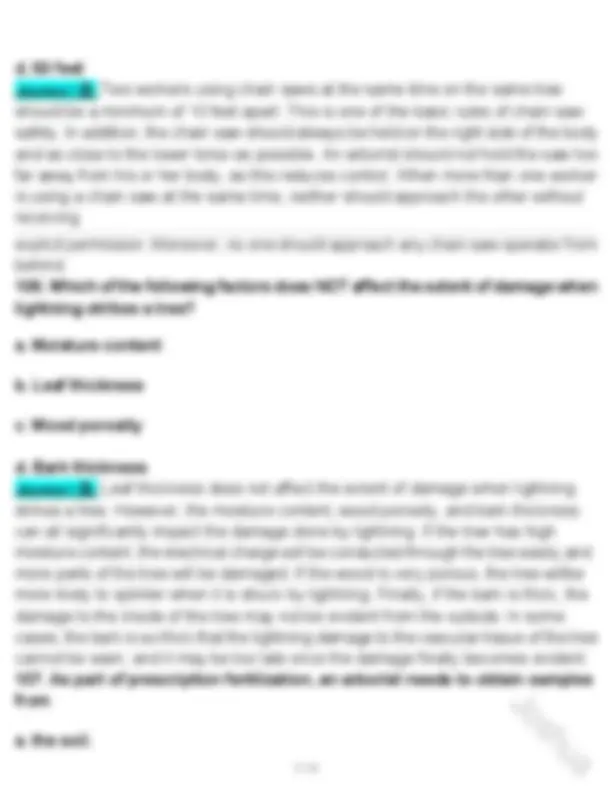
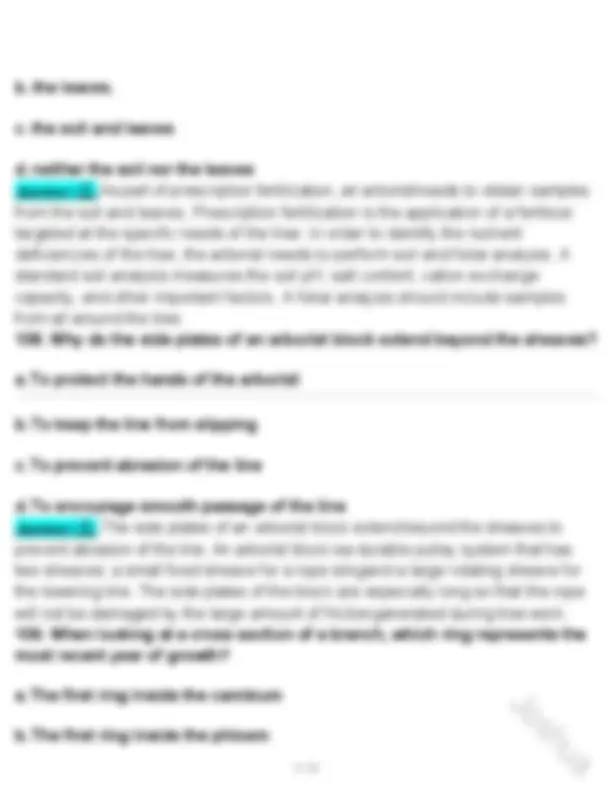
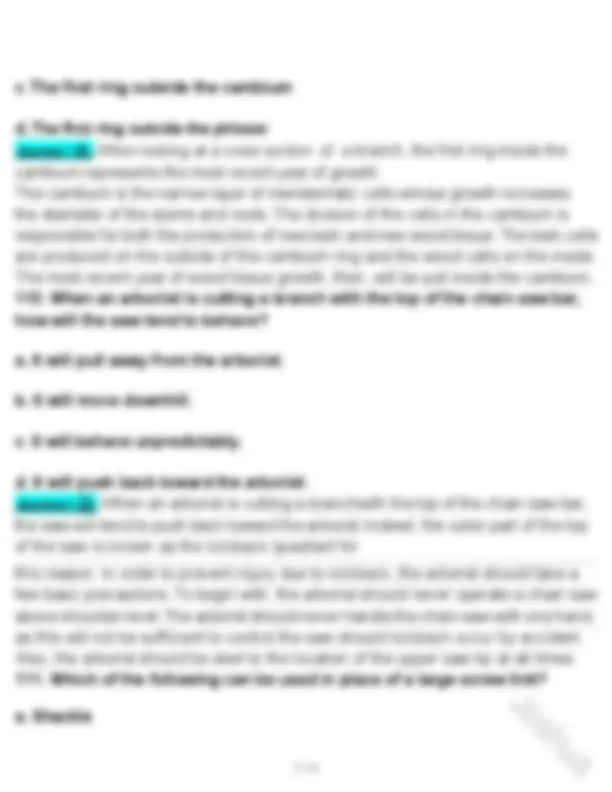
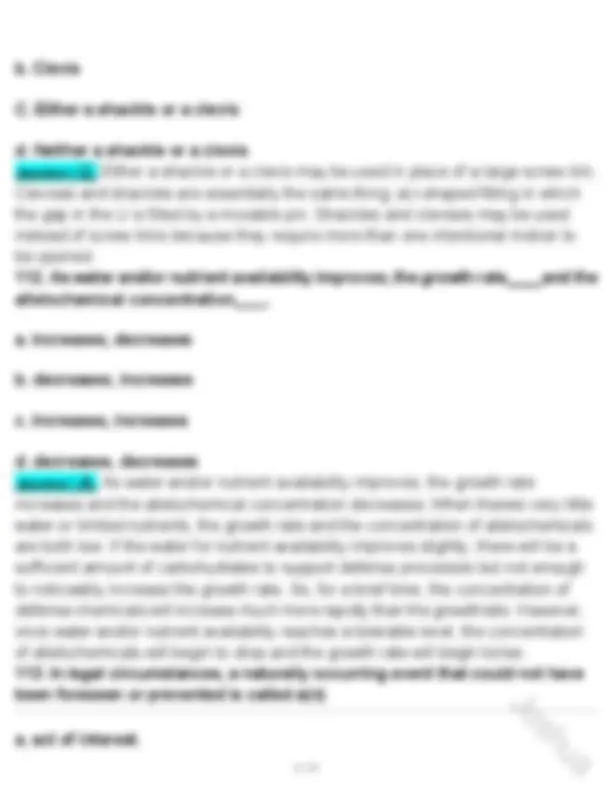
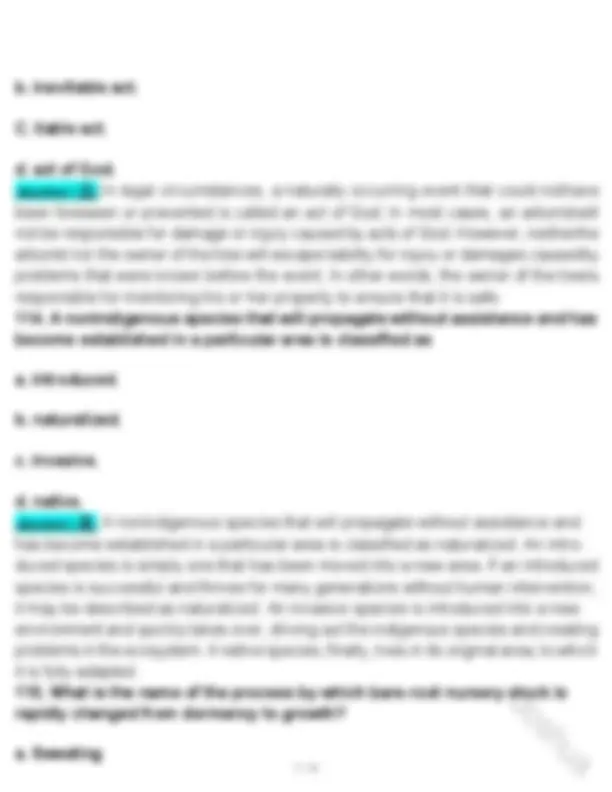
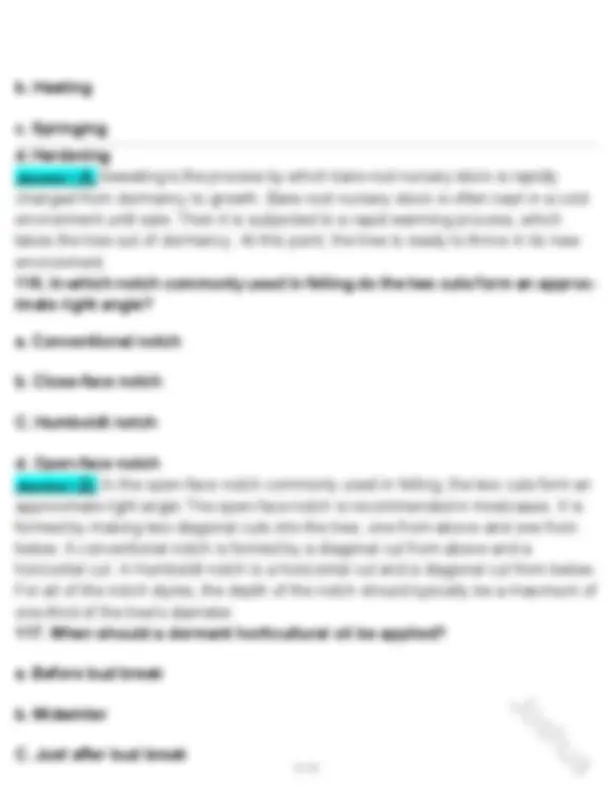
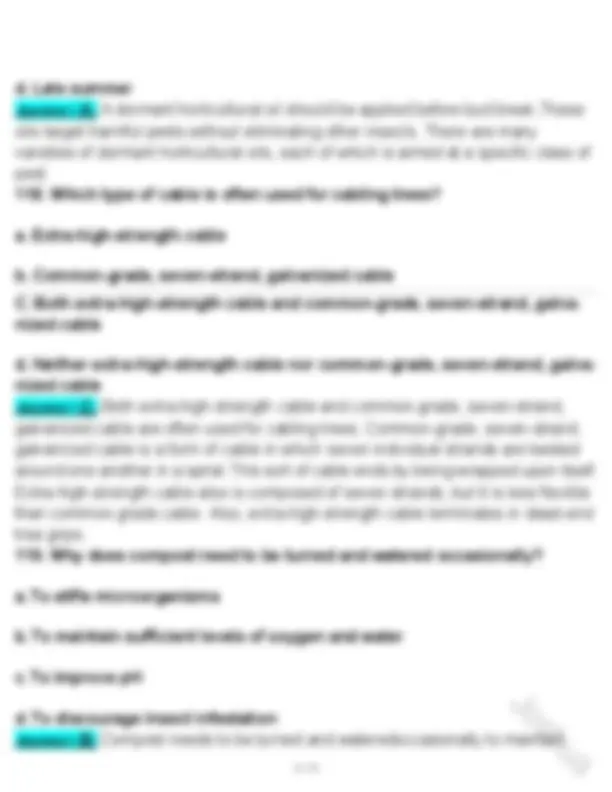
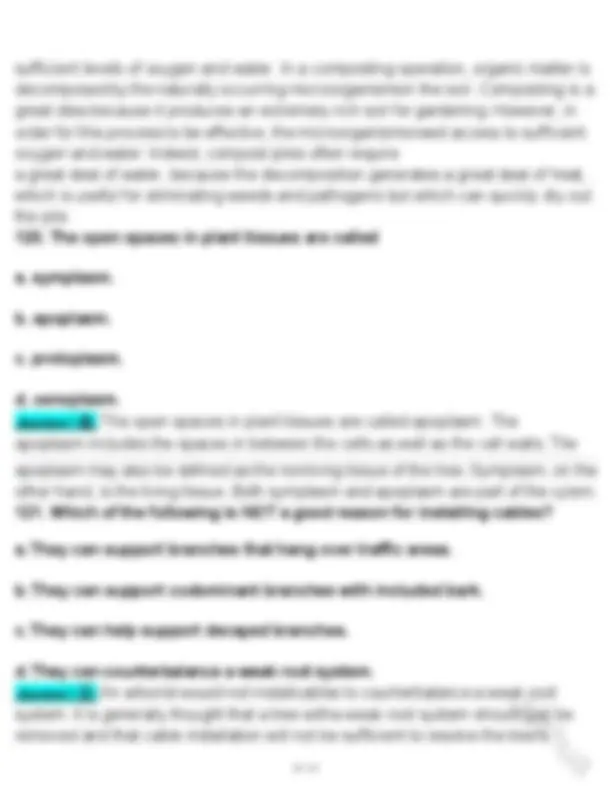
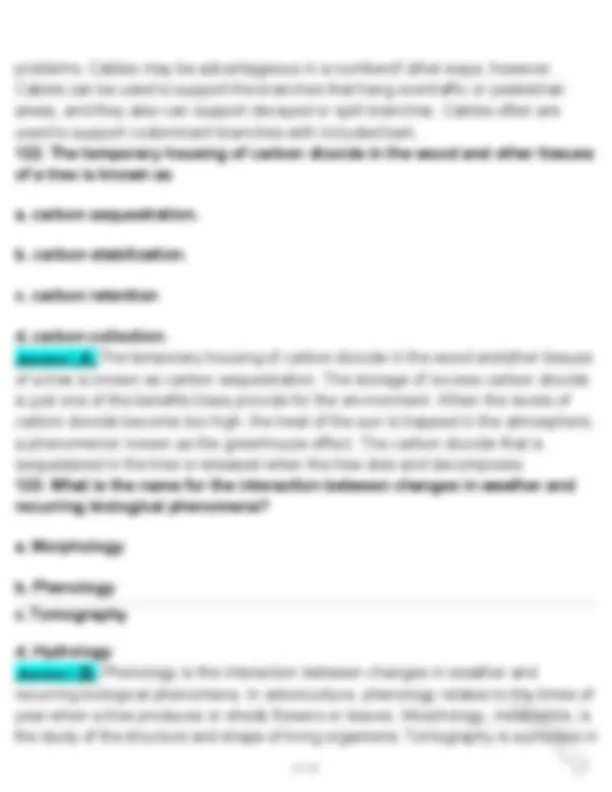
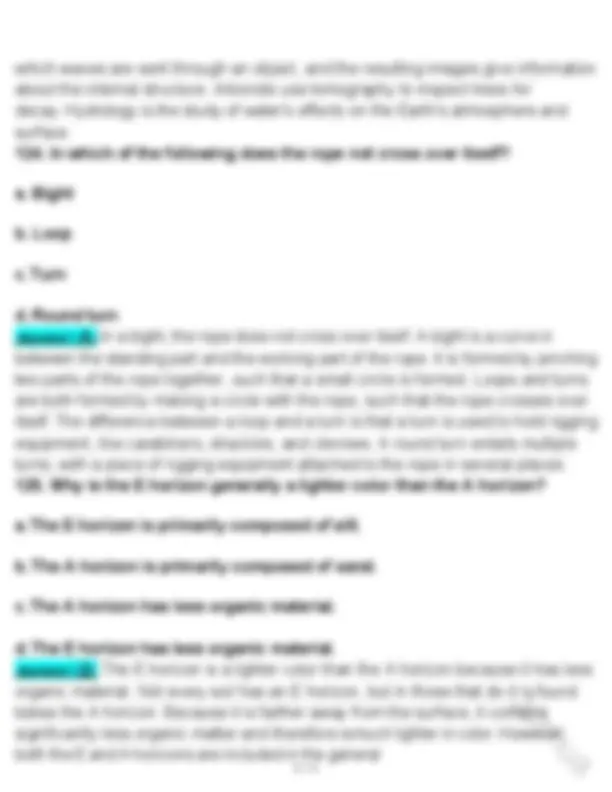
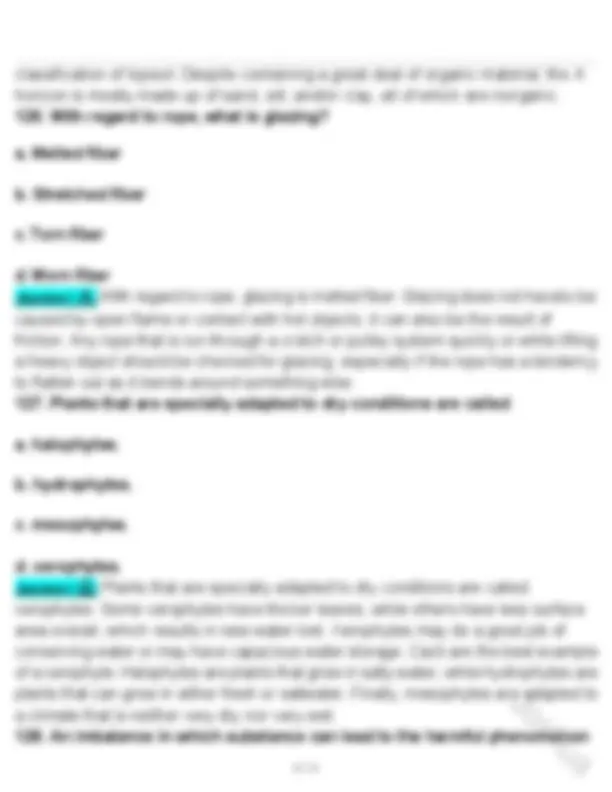
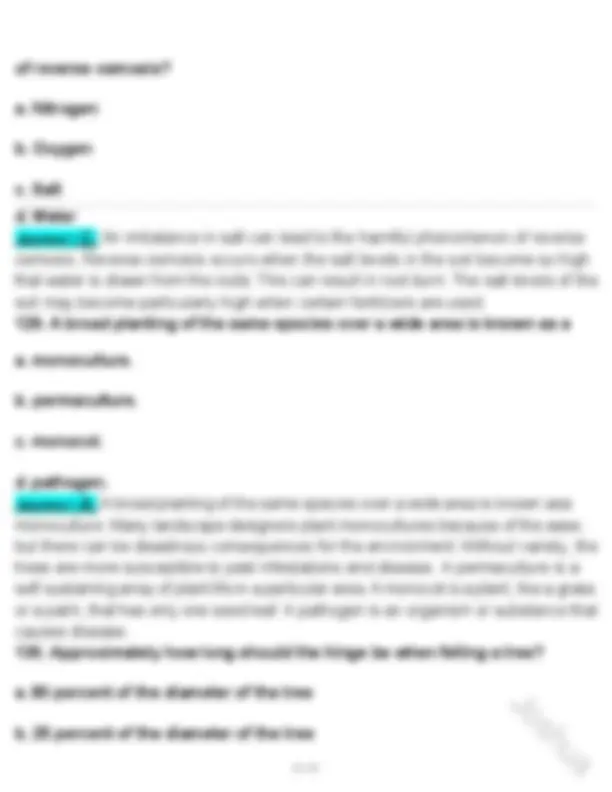
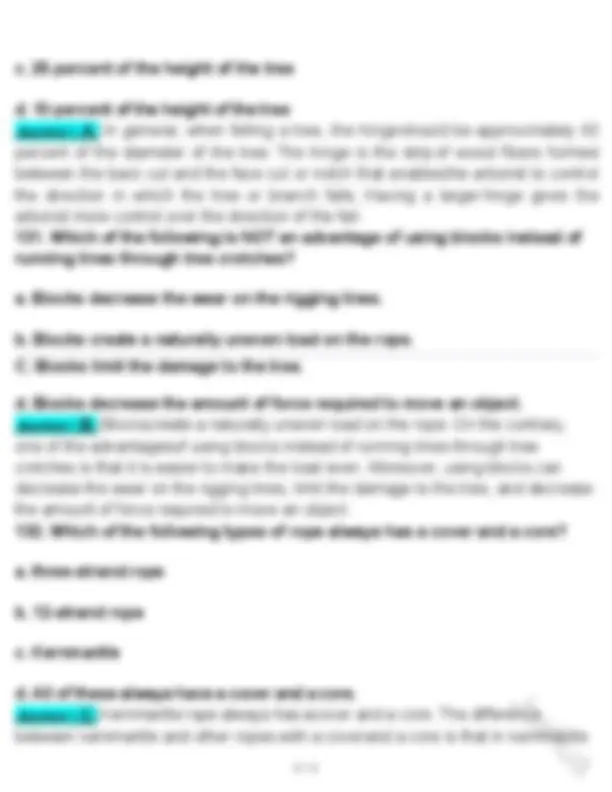
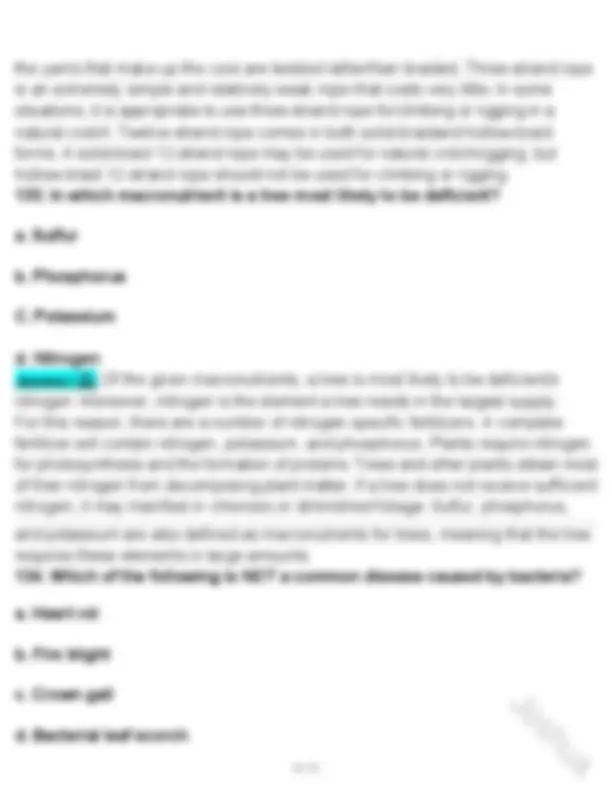
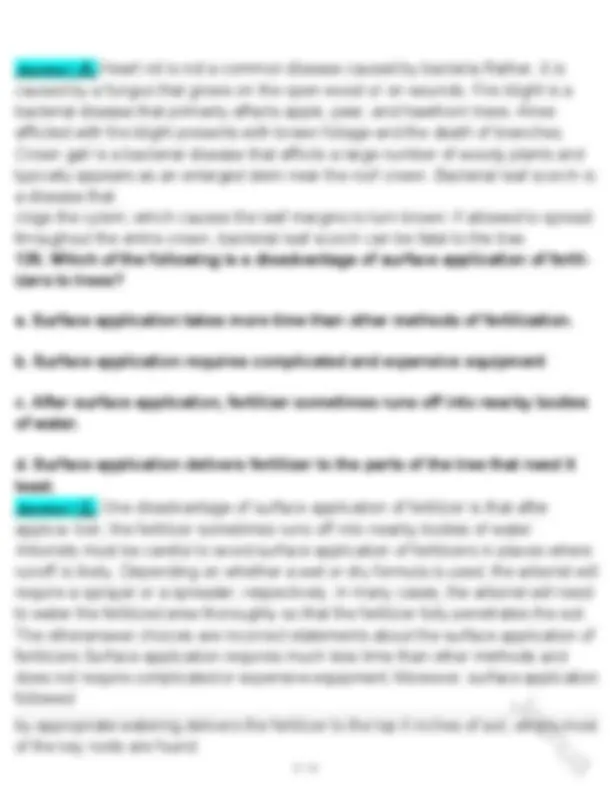
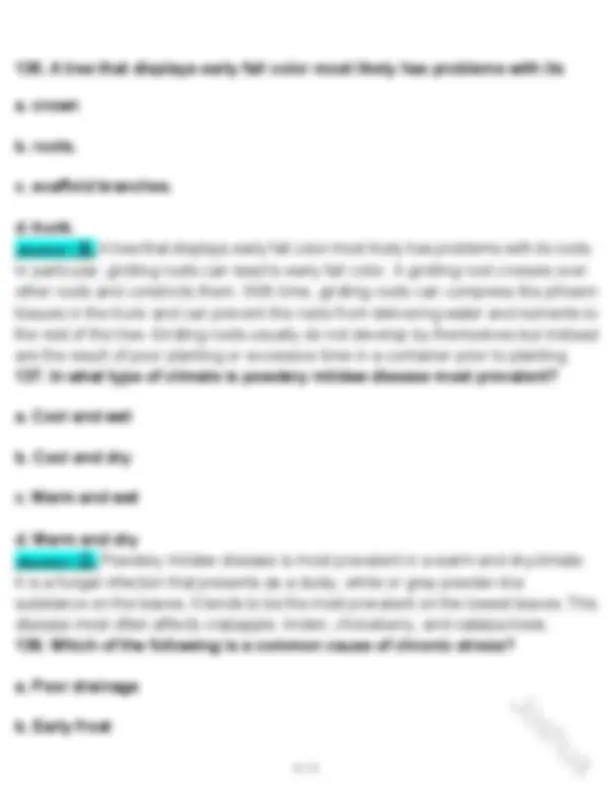
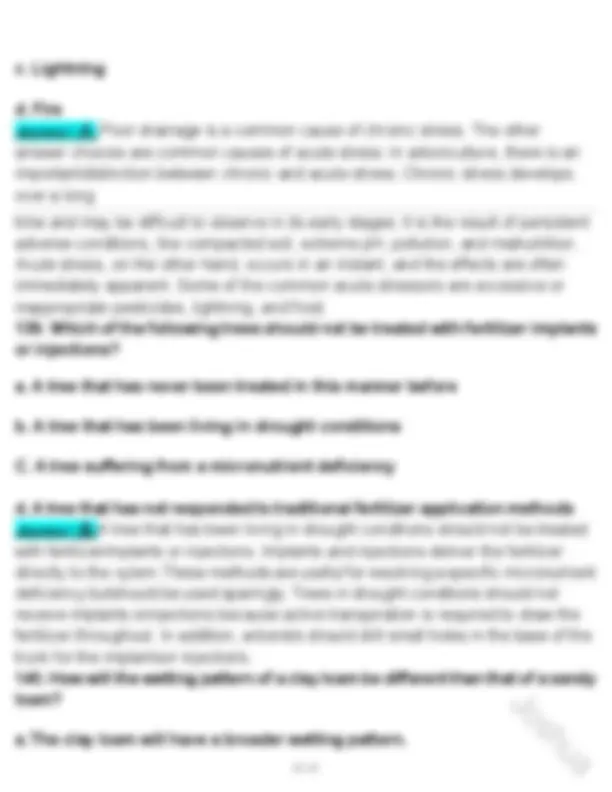

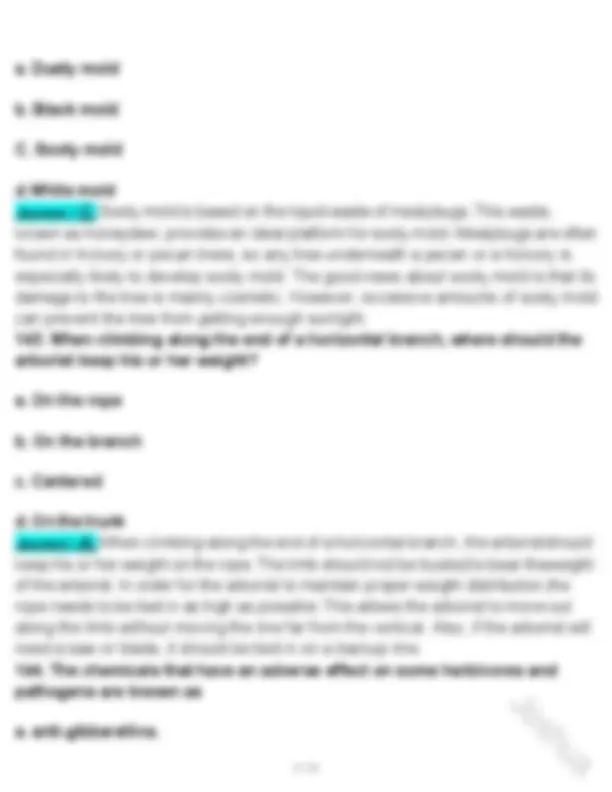
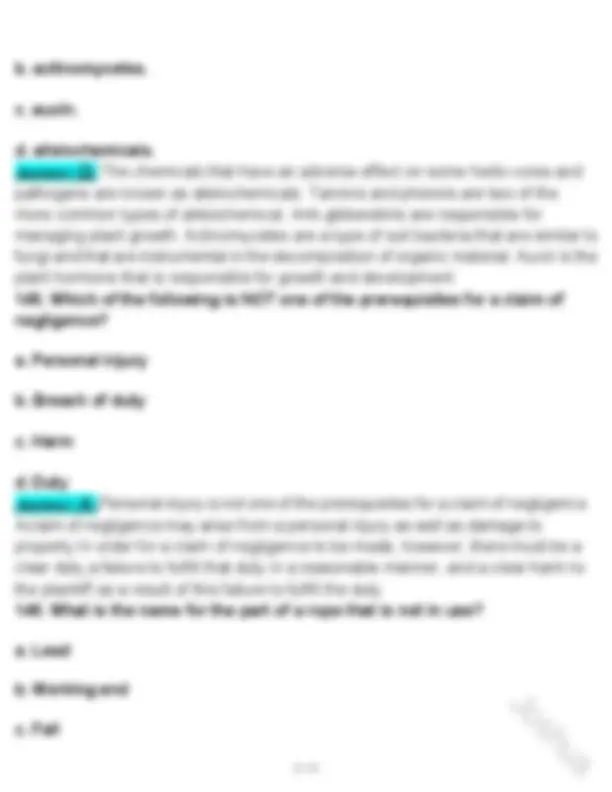
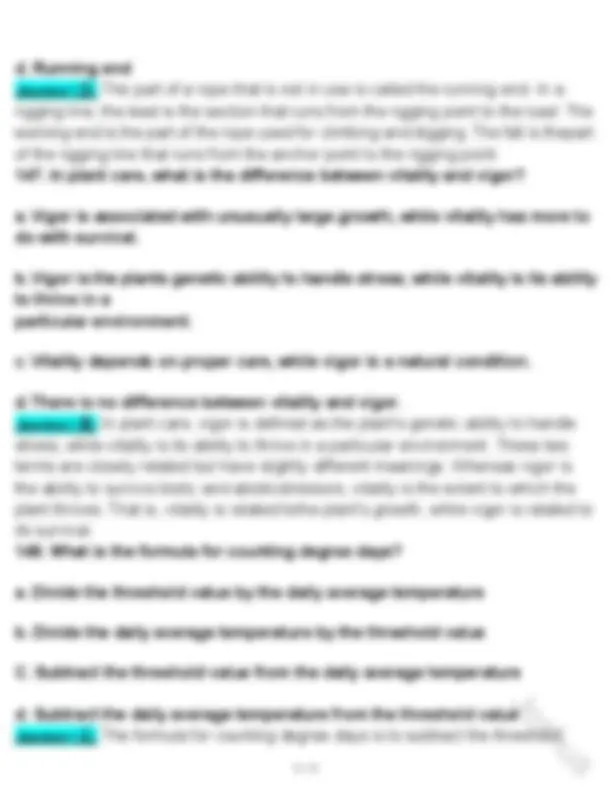

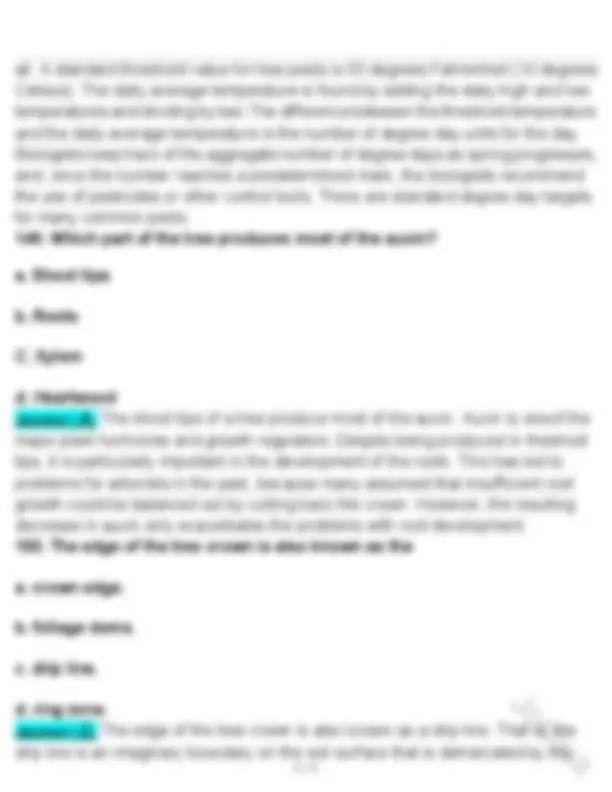
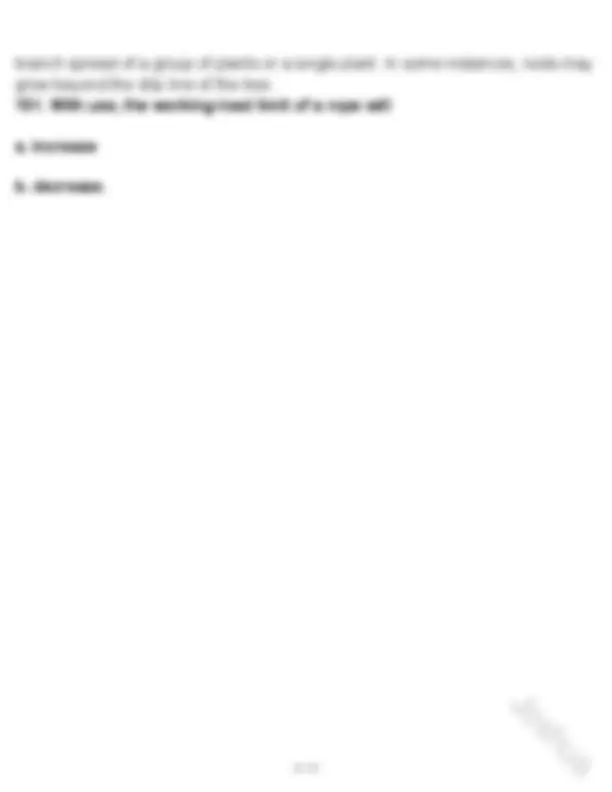
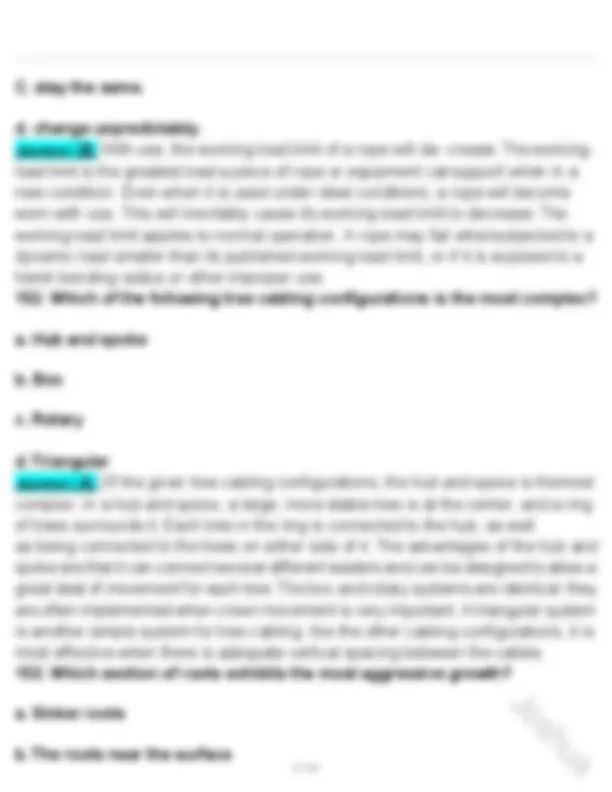
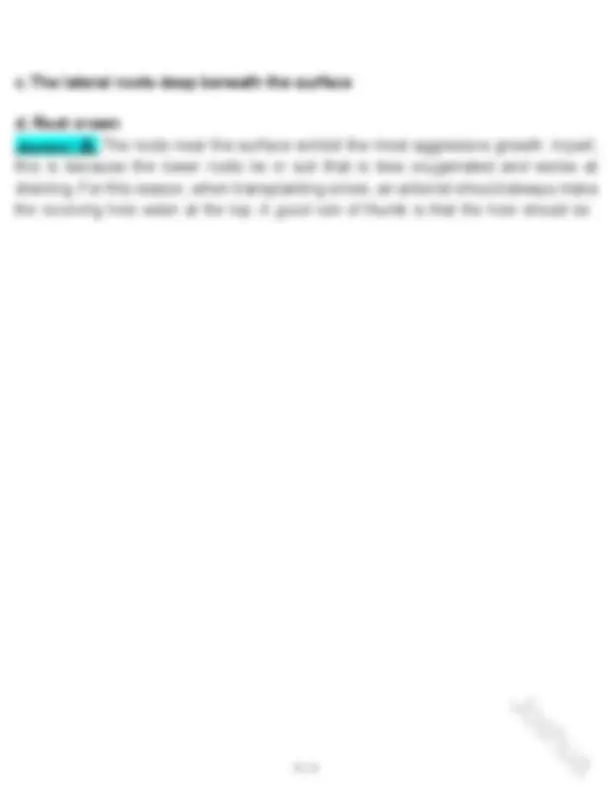
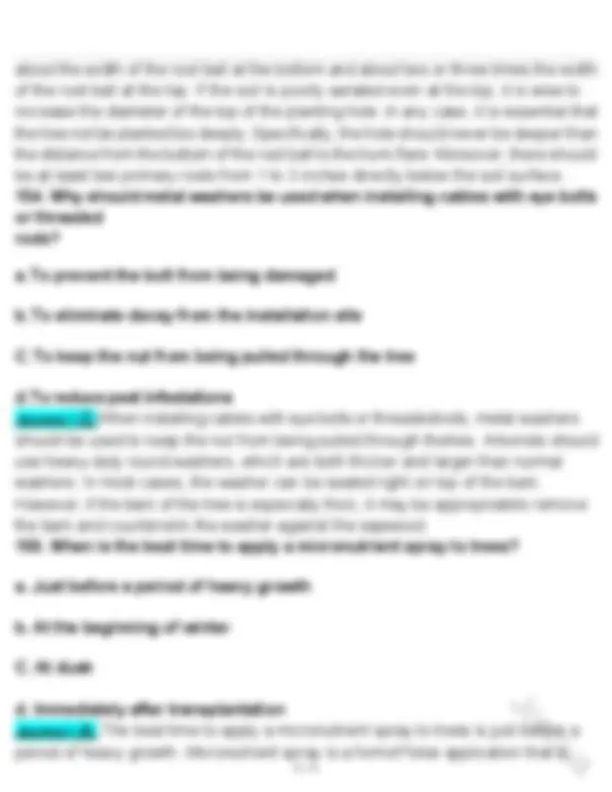



Study with the several resources on Docsity

Earn points by helping other students or get them with a premium plan


Prepare for your exams
Study with the several resources on Docsity

Earn points to download
Earn points by helping other students or get them with a premium plan
Community
Ask the community for help and clear up your study doubts
Discover the best universities in your country according to Docsity users
Free resources
Download our free guides on studying techniques, anxiety management strategies, and thesis advice from Docsity tutors
A comprehensive set of questions and answers for the isa certified arborist exam. It covers a wide range of topics related to arboriculture, including tree care, pest management, pruning techniques, and safety practices. Designed to help aspiring arborists prepare for the exam and gain a deeper understanding of the field.
Typology: Exams
1 / 138

This page cannot be seen from the preview
Don't miss anything!





























































































test consisting of 200 multiple-choice ques with Ans
a. hydrozones
b. aquasets. C. drought zones.
d. xeriscapes.
water are called hydrozones. Arborists often arrange trees in hydrozones so that watering is easier and less confusing. In addition, when there are variations in elevation at a particular site, the arborist may place trees that need more water at the higher elevations, so that the trees downhill can subsist entirely on the runoff from the water applied to the higher trees.
a. To introduce species that prey on pests
b. To promote insect populations
C. To eradicate pests
d. To maintain a tolerable level of pest damage
of pest damage. Integrated pest man-agement was originally devised as an alternative to a reliance on pesticides. It recommends a holistic approach to pest control, which may include limited use of pesticides. More importantly, however, integrated pest management strategies create as little of a disturbance to the preexisting environment as possible and prioritize limiting collateral damage to the non-target organisms (most notably, people).
a. Thinning cut
b. Reduction cut
C. Heading cut
d. Pruning cut
scorned form of pruning in which the top of the tree is lopped off to a certain height. Besides being aesthetically unpleasant, topping has a number of negative consequences for trees. First, topping drastically reduces the volume of the leaf crown, which makes it extremely difficult for the tree to produce enough food. Topping also makes the tree more susceptible to sun damage, disease, and insect infestation. Finally, topping encourages the growth of numerous weak sprouts from the top of
d. Along the intended direction of the fall
should move along a line 45-degrees to either sideof a line opposite to the intended direction of the fall. Moreover, there should not beany other people in the area immediately behind the tree. Many arborists keep fellingwedges on hand while the back cut is being made. If necessary, these wedges canbe useful for keeping the tree from pinching the bar of the chain saw. Arborists canalso use felling wages to begin and control the fall.
a. The right side of the tree
b. The left side of the tree
c. Uphill from the tree
d. Downhill from the tree
to prevent the tree from rolling over on the worker. In some cases,the arborist will need to use a wedge or a block to keep the tree from moving. When multiple workers are limbing or bucking the same tree at the same time, theyneed to be in constant communication, and should have a pre-established system for approaching or alerting one another. Limbing is the process of cutting the side branches off a tree that has been felled. Bucking is the process of cutting a tree trunk or log into shorter sections that are easier to manipulate.
a. Dieback
b. Leaf blotch
C. Scorch
c. Gummosis
leaf. Blotches are typically caused by dryness, frost, fungus, chemical spray, sunscald, or insects. Dieback is the gradual death of leaves and twigs, progressingfrom the tip back towards the base. It is generally the result of specific nutrient imbalances, air pollution, vascular disease, or root damage. Scorch occurs when leaves turn brown and black and when areas around the leaf edges and margins die. Gummosis is oozing gum or sap from wounds or other openings in the bark.
a. Propping
b. Peening
C. Guying
c. Dead-ending
tree bracing operation. Peening is essentially just hammering the bolt ends so that they expand around the nuts. Propping is a technique for supporting a weak ordamaged limb. Guying is another support technique. It is the installation of a cablebetween a tree and an external object.
d. Along the same line
cable. This arrangement maximizes the strength of the hardware. If the cable pulls on the line at an angle, the forces exerted on the hardware will be asymmetrical, and therefore the hardware will not be able to function at its optimal strength.
a. After the blooms are shed
b. After the first frost of the autumn
c. Just after they bloom
d. Winter
pruned just after they bloom, ensuring that blooming buds are not removed from the plant. Although timing is important in the promotion or discouraging of flowers or fruit, it is less significant in the removal of dead, diseased, or broken branches, which can be removed at any time of year.
a. 1 foot for each inch of trunk diameter
b. Two times the trunk diameter
c. At least 3 feet
d. 10 feet
the trunk of a young tree at least 1 foot for each inch of trunk diameter. The tree protection zone is intended to prevent digging and earth moving from adversely affecting the roots. Ideally, the tree protection zone would extend much farther, but at the very least the above guideline should be followed. A larger or older tree would need an even larger protection zone, since its root spread would be much broader.
a. Mites
b. Adversive environmental conditions
c. Insects
d. Pathogens
problems. Indeed, over 70 percent of all tree problems stem from environmental stressors such as soil compaction, mechanical injury, drought, and extremes of temperature or moisture. Environmental and cultural practices can often have a stronger effect than most insect or pathogen related disorders. However, in most cases environmental stressors are combined with biotic stressors to exacerbate the problem. In particular, trees that have been weakened by environmental problems are often much more susceptible to invasions and infestations by pests.
a. Nitrogen
b. Potassium
C. Calcium
d. Phosphorus
fertilizer must include nitrogen, potassium, and phosphorus. Indeed, the standard
meanwhile, is a chemical and physical barrier between the stem and the trunk. A branch protection zone can prevent disease or decay within the branch from reaching the trunk, but it is usually absent when there are codominant stems. A branch collar is an enlarged area at the base of a branch, formed by the overlapping of the branch and trunk bark tissue. The branch collar provides extra support for the branch. A branch bark ridge is a strip of bark atop the branch union, created by the growth of the trunk or the parent stem. Again, this structure will provide extra support, but it is either absent or ineffectively formed when there are codominant stems.
a. Complete fertilizer
b. Liquid fertilizer
c. Injection fertilizer
d. Slow-release nitrogen fertilizer
planted trees to encourage root exploration and to providea steady low-salt nutrient source for establishing trees. Generally, most trees do notneed supplementary fertilizer to thrive unless there exist soil conditions that are lowin certain nutrients or nutrients are tied up in a form that makes them unavailable to the plant.
a. nitrogen
b. carbon
c. oxygen
d. helium
atmosphere. Trees, along with other plants, are able to counteract this phenomenon through a process known as carbon sequestration. Carbon dioxide is absorbed into tree tissue, where it remains until the tree dies and decomposes. Trees represent an important element of the carbon cycle.
It was long recommended that the back be straight when lifting heavy objects, but recent research has suggested that it may be better to maintain a normal posture, at least in terms of back curvature. Some researchers believe that paying too close attention to the curvature of the back makes people lift primarily with the back rather than the legs, which is a more serious error.
a. B
b. 0
c. A
d. C
orderby the A, B, and C horizons. A horizon is a layer of soil. The o horizon is primarily composed of decomposing organic matter. The A horizon contains sand, clay, andsilt and is darker than the layers beneath. The B horizon is a mixture of organic material from above and parent material from below. The Chorizon is where soil iscreated from the parent material. The Chorizon lies just above the bedrock.
a. Location of the tree
b. Intended function of the tree
c. Both location and function
d. Neither location nor function
height of the lowest permanent branch during structural prun- ing. Structural pruning is meant to improve the appearance, health, and longevity ofthe tree by encouraging a healthy and sound growth pattern. The arborist typically will select
a dominant leader and identify the main permanent support branches. The arborist may prune away some of the other branches or may leave them for the time being if they will help support the development of the permanent branches.The height of the lowest permanent branch is left to the discretion of the arborist. If the tree is close to a sidewalk or path, the lowest permanent branch may need to be high enough to allow pedestrian traffic. If the tree stands alone, away from pedestrian thoroughfares, then the lowest permanent branch can be lower.
a. inflorescence.
b. frond.
c. monocot.
d. petiole.
some palm trees, inflorescences may consist of many tiny flowers, which in turn means that the tree will produce a large number of fruit. A frond is a palm leaf. Fronds are large and have a segmented leaf structure. Palms are classified as monocots, a group of plants that do not have growth rings or a cambium. The vascular system of a monocot is distributed throughout the stem and protected by parenchymal cells and dense wood fiber. A petiole is the base of a leaf stalk.
a. The working-load limit is lower than the tensile strength.
b. The working-load limit is higher than the tensile strength.
C. The working-load limit is the same as the tensile strength.
d. The working-load limit is unrelated to the tensile strength.
strength. The working-loadlimit is the largest load a rope, piece of equipment, or
a. shoots, roots
b. roots, leaves
C. roots, shoots
d. shoots, trunk
the shoots. These hormones are in many ways the counterpart to auxin,which is produced in the shoots but is an essential part of root growth. Cytokinins encourage cell division in the shoots.
a. acclimation.
b. aggregation.
c. hardening off.
d. selection.
variations in its environment is called acclimation. Any tree that is to survive conditions unlike those where it originates will have to acclimate. Aggregation, on the other hand, is a gathering together, as of soil particles. In arboriculture, hardening off is the process by which the outermost plant tissue adjusts to a new, often colder environment.
a. 10 percent
b. 25 percent
c. 45 percent
d. 80 percent
may include sand, clay, and silt. These components of the soil derived fromthe parent material, that is, the bedrock underlying the soil. The ideal soil will be
halfway made up of pore space, which may be either water or air. The remaining 5 percent of the ideal soil is organic matter and organisms.
a. 4 pounds of nitrogen per thousand square feet of root area
b. 40 pounds of nitrogen per thousand square feet of root area
c. 10 pounds of nitrogen per thousand square feet of root area
d. 100 pounds of nitrogen per thousand square feet of root area
typical concentrationfor slow-release supplemental nitrogen fertilizers used under normal conditions. However, an arborist should be alert to the environmental conditions that could require a greater or smaller concentration. For instance, the tree species, health, and age, and soil texture may all affect the choice of fertilizer. Similarly, the form inwhich the fertilizer is to be applied is often relevant. It is rare, however, for a fertilizerto be applied in a concentration greater than 6 pounds per thousand square feet ofroot area.
a. Running bowline
b. Midline clove hitch
d. Two stems with roughly equal size that grow from the same place
from the sameplace. Codominance is not a desirable trait, because the union between the stemsis typically quite weak. Codominant stems lack a branch bark ridge and do not forma branch collar. In other words, the area at the base of the stems is less fortified than it would be if there were a single dominant stem. Also, codominant stems aremore likely to have included bark, which is lodged between the stems, creating a structural weakness prone to failure.
a. On the ground
b. Leglock method
c. Drop starting
d. All of these methods are recommended.
Drop starting is pulling the starter cord while pushing the saw away from the body. One reason why drop starting is not recommended is that it creates an opportunity for the operator to come into contactwith a moving chain. In the leglock method, the saw is positioned behind the right knee. This technique is sometimes used in favor of simply starting the saw with it lying on the ground, which is the safest method.
a. Air terminal
b. Ground terminal
C. Conductors
d. Battery
tection system must include an air terminal, ground terminal, and set of conductors. The purpose of the system is to divert the electrical energy from lightning away from the tree. The air terminal is placed at the top of the tree, and the conductors run down the central branches to the trunk and then down to the ground. The conductors are typically made of copper, which allows for the easy passage of electricity. It will be necessary to attach the conductor to the tree every few feet. It is only necessary to install one conductor if the diameter of the tree crown is less than 35 feet; broader trees may need secondary conductors along a few of the main branches. These secondary conductors should connect to the main conductor. The main conductor connects to a ground terminal, which typically consists of a set of rods or plates. The ground terminal should not be placed within 2 feet of underground installations or structures. The ground terminal should be at least 8 inches deep underground
a. Location
b. Health
c. Size
d. Foliage: C. In the CTLA trunk formula method, the primary determinant of a tree's value is size. The CTLA approach was created by the Council of Tree and Landscape Appraisers. It is important to distinguish between the trunk formula method composed by the CTLA and the CTLA methodology, which is a more holistic assessment rubric for tree health. The CTLA methodology combines scores related to location, species, size, and condition when assessing a tree.
a. At least to the drip line